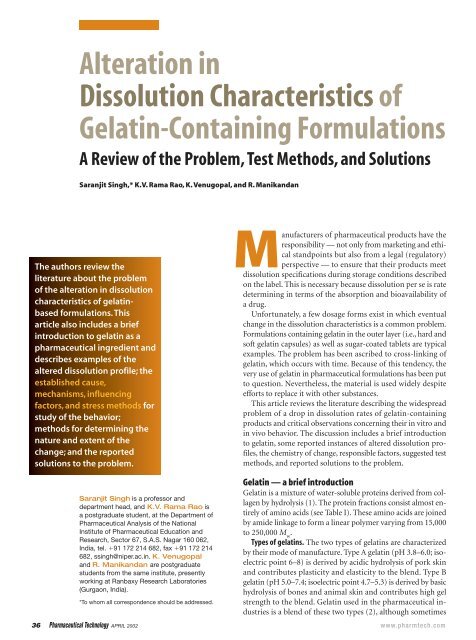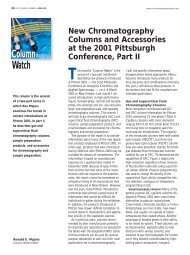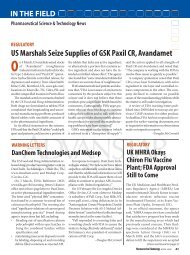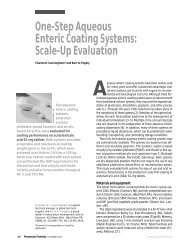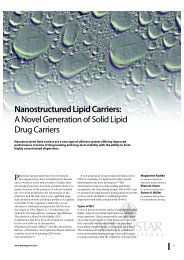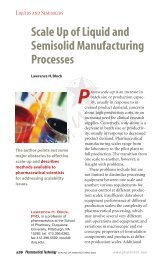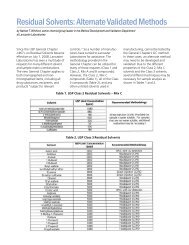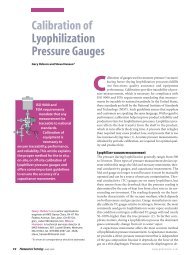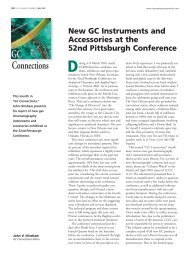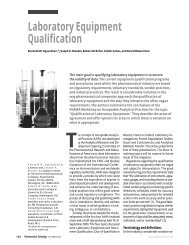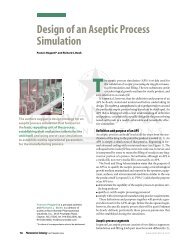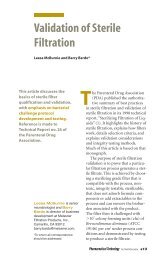Alteration in Dissolution Characteristics of Gelatin-Containing ...
Alteration in Dissolution Characteristics of Gelatin-Containing ...
Alteration in Dissolution Characteristics of Gelatin-Containing ...
You also want an ePaper? Increase the reach of your titles
YUMPU automatically turns print PDFs into web optimized ePapers that Google loves.
<strong>Alteration</strong> <strong>in</strong><br />
<strong>Dissolution</strong> <strong>Characteristics</strong> <strong>of</strong><br />
Gelat<strong>in</strong>-Conta<strong>in</strong><strong>in</strong>g Formulations<br />
A Review <strong>of</strong> the Problem, Test Methods, and Solutions<br />
Saranjit S<strong>in</strong>gh,* K.V. Rama Rao, K. Venugopal, and R. Manikandan<br />
The authors review the<br />
literature about the problem<br />
<strong>of</strong> the alteration <strong>in</strong> dissolution<br />
characteristics <strong>of</strong> gelat<strong>in</strong>based<br />
formulations.This<br />
article also <strong>in</strong>cludes a brief<br />
<strong>in</strong>troduction to gelat<strong>in</strong> as a<br />
pharmaceutical <strong>in</strong>gredient and<br />
describes examples <strong>of</strong> the<br />
altered dissolution pr<strong>of</strong>ile; the<br />
established cause,<br />
mechanisms, <strong>in</strong>fluenc<strong>in</strong>g<br />
factors, and stress methods for<br />
study <strong>of</strong> the behavior;<br />
methods for determ<strong>in</strong><strong>in</strong>g the<br />
nature and extent <strong>of</strong> the<br />
change; and the reported<br />
solutions to the problem.<br />
Manufacturers <strong>of</strong> pharmaceutical products have the<br />
responsibility — not only from market<strong>in</strong>g and ethical<br />
standpo<strong>in</strong>ts but also from a legal (regulatory)<br />
perspective — to ensure that their products meet<br />
dissolution specifications dur<strong>in</strong>g storage conditions described<br />
on the label. This is necessary because dissolution per se is rate<br />
determ<strong>in</strong><strong>in</strong>g <strong>in</strong> terms <strong>of</strong> the absorption and bioavailability <strong>of</strong><br />
a drug.<br />
Unfortunately, a few dosage forms exist <strong>in</strong> which eventual<br />
change <strong>in</strong> the dissolution characteristics is a common problem.<br />
Formulations conta<strong>in</strong><strong>in</strong>g gelat<strong>in</strong> <strong>in</strong> the outer layer (i.e., hard and<br />
s<strong>of</strong>t gelat<strong>in</strong> capsules) as well as sugar-coated tablets are typical<br />
examples. The problem has been ascribed to cross-l<strong>in</strong>k<strong>in</strong>g <strong>of</strong><br />
gelat<strong>in</strong>, which occurs with time. Because <strong>of</strong> this tendency, the<br />
very use <strong>of</strong> gelat<strong>in</strong> <strong>in</strong> pharmaceutical formulations has been put<br />
to question. Nevertheless, the material is used widely despite<br />
efforts to replace it with other substances.<br />
This article reviews the literature describ<strong>in</strong>g the widespread<br />
problem <strong>of</strong> a drop <strong>in</strong> dissolution rates <strong>of</strong> gelat<strong>in</strong>-conta<strong>in</strong><strong>in</strong>g<br />
products and critical observations concern<strong>in</strong>g their <strong>in</strong> vitro and<br />
<strong>in</strong> vivo behavior. The discussion <strong>in</strong>cludes a brief <strong>in</strong>troduction<br />
to gelat<strong>in</strong>, some reported <strong>in</strong>stances <strong>of</strong> altered dissolution pr<strong>of</strong>iles,<br />
the chemistry <strong>of</strong> change, responsible factors, suggested test<br />
methods, and reported solutions to the problem.<br />
Saranjit S<strong>in</strong>gh is a pr<strong>of</strong>essor and<br />
department head, and K.V. Rama Rao is<br />
a postgraduate student, at the Department <strong>of</strong><br />
Pharmaceutical Analysis <strong>of</strong> the National<br />
Institute <strong>of</strong> Pharmaceutical Education and<br />
Research, Sector 67, S.A.S. Nagar 160 062,<br />
India, tel. 91 172 214 682, fax 91 172 214<br />
682, ss<strong>in</strong>gh@niper.ac.<strong>in</strong>. K. Venugopal<br />
and R. Manikandan are postgraduate<br />
students from the same <strong>in</strong>stitute, presently<br />
work<strong>in</strong>g at Ranbaxy Research Laboratories<br />
(Gurgaon, India).<br />
*To whom all correspondence should be addressed.<br />
Gelat<strong>in</strong> — a brief <strong>in</strong>troduction<br />
Gelat<strong>in</strong> is a mixture <strong>of</strong> water-soluble prote<strong>in</strong>s derived from collagen<br />
by hydrolysis (1). The prote<strong>in</strong> fractions consist almost entirely<br />
<strong>of</strong> am<strong>in</strong>o acids (see Table I). These am<strong>in</strong>o acids are jo<strong>in</strong>ed<br />
by amide l<strong>in</strong>kage to form a l<strong>in</strong>ear polymer vary<strong>in</strong>g from 15,000<br />
to 250,000 M w<br />
.<br />
Types <strong>of</strong> gelat<strong>in</strong>s. The two types <strong>of</strong> gelat<strong>in</strong>s are characterized<br />
by their mode <strong>of</strong> manufacture. Type A gelat<strong>in</strong> (pH 3.8–6.0; isoelectric<br />
po<strong>in</strong>t 6–8) is derived by acidic hydrolysis <strong>of</strong> pork sk<strong>in</strong><br />
and contributes plasticity and elasticity to the blend. Type B<br />
gelat<strong>in</strong> (pH 5.0–7.4; isoelectric po<strong>in</strong>t 4.7–5.3) is derived by basic<br />
hydrolysis <strong>of</strong> bones and animal sk<strong>in</strong> and contributes high gel<br />
strength to the blend. Gelat<strong>in</strong> used <strong>in</strong> the pharmaceutical <strong>in</strong>dustries<br />
is a blend <strong>of</strong> these two types (2), although sometimes<br />
36 Pharmaceutical Technology APRIL 2002 www.pharmtech.com
Table I: Am<strong>in</strong>o acids and<br />
their content <strong>in</strong> gelat<strong>in</strong>.<br />
Percentage<br />
Glyc<strong>in</strong>e 25.5<br />
Prol<strong>in</strong>e 18.0<br />
Hydroxyprol<strong>in</strong>e 14.1<br />
Glutamic acid 11.4<br />
Alan<strong>in</strong>e 8.5<br />
Arg<strong>in</strong><strong>in</strong>e 8.5<br />
Aspartic acid 6.6<br />
Lys<strong>in</strong>e 4.1<br />
Leuc<strong>in</strong>e 3.2<br />
Val<strong>in</strong>e 2.5<br />
Phenylalan<strong>in</strong>e 2.2<br />
Threon<strong>in</strong>e 1.9<br />
Isoleuc<strong>in</strong>e 1.4<br />
Methion<strong>in</strong>e 1.0<br />
Histid<strong>in</strong>e 0.8<br />
Tyros<strong>in</strong>e 0.5<br />
Ser<strong>in</strong>e 0.4<br />
Cyst<strong>in</strong>e 0.1<br />
Cyste<strong>in</strong>e 0.1<br />
only Type A or Type B is used. Various grades <strong>of</strong><br />
gelat<strong>in</strong> with differ<strong>in</strong>g particle sizes and molecular Am<strong>in</strong>o Acid<br />
weight are sold commercially <strong>in</strong> the form <strong>of</strong> translucent<br />
sheets, granules, or powders. Gelat<strong>in</strong> usually<br />
is graded accord<strong>in</strong>g to jelly strength, expressed as<br />
bloom strength, which is the weight <strong>in</strong> grams that,<br />
when applied with a 12.7 mm–diameter plunger,<br />
will produce a depression exactly 4 mm deep <strong>in</strong> a<br />
matured jelly conta<strong>in</strong><strong>in</strong>g 6.66% w/w <strong>of</strong> gelat<strong>in</strong> <strong>in</strong><br />
water.<br />
Properties. Gelat<strong>in</strong> is practically odorless and<br />
tasteless. It is <strong>in</strong>soluble <strong>in</strong> acetone, chlor<strong>of</strong>orm,<br />
ethanol (95%), ether, and methanol. It is soluble<br />
<strong>in</strong> glycer<strong>in</strong>, acids, and alkalis, although strong acids<br />
or alkalis cause its precipitation. It swells and s<strong>of</strong>tens<br />
<strong>in</strong> water, gradually absorb<strong>in</strong>g 5 to 10 times its<br />
own weight <strong>in</strong> water. It solubilizes <strong>in</strong> hot water.<br />
Upon cool<strong>in</strong>g to 35–40 °C, it forms a jelly or gel.<br />
At temperatures 40 °C, the system exists as a sol.<br />
A gel <strong>of</strong> higher viscosity is formed <strong>in</strong> alkal<strong>in</strong>e media<br />
as compared with acid media (3).<br />
Because it is a prote<strong>in</strong>, gelat<strong>in</strong> exhibits chemical<br />
properties characteristic <strong>of</strong> those materials (e.g., gelat<strong>in</strong> is<br />
hydrolyzed by most <strong>of</strong> the proteolytic systems to yield its am<strong>in</strong>o<br />
components). Gelat<strong>in</strong> reacts with acids and bases, aldehydes<br />
and aldehydic sugars, anionic and cationic polymers, electrolytes,<br />
metal ions, plasticizers, preservatives, and surfactants.<br />
Applications and uses. Gelat<strong>in</strong> is valuable to the pharmaceutical<br />
<strong>in</strong>dustry because it can be <strong>in</strong>corporated <strong>in</strong>to a variety <strong>of</strong><br />
formulations. It is the only <strong>in</strong>gredient used to form hard and<br />
s<strong>of</strong>t elastic gelat<strong>in</strong> capsules (SEGCs). It is widely used <strong>in</strong> solutions,<br />
syrups, tablets, sugar-coated tablets, <strong>in</strong>halants, and dental,<br />
vag<strong>in</strong>al, and topical preparations and <strong>in</strong>jections. Its other<br />
uses <strong>in</strong>clude the preparation <strong>of</strong> pastes, pastilles, pessaries, and<br />
suppositories. In addition, it is used as a vehicle for parenteral<br />
formulations and as a tablet b<strong>in</strong>der and coat<strong>in</strong>g agent. Low<br />
molecular weight gelat<strong>in</strong> has been <strong>in</strong>vestigated for its ability to<br />
enhance dissolution <strong>of</strong> orally <strong>in</strong>gested drugs.<br />
Gelat<strong>in</strong> also is used for the microencapsulation <strong>of</strong> drugs, a<br />
process whereby the active drug is sealed <strong>in</strong>side a microsized<br />
capsule that then may be handled as a powder. Gelat<strong>in</strong> forms<br />
simple coacervates at temperatures 40 °C <strong>in</strong> the presence <strong>of</strong><br />
dehydrat<strong>in</strong>g agents such as ethanol or 7% sodium sulfate solution.<br />
Peters et al. studied the properties <strong>of</strong> gelat<strong>in</strong> <strong>in</strong> complex<br />
coacervation processes (4). Gelat<strong>in</strong> capsules also can be coated<br />
for any application (5). S<strong>of</strong>t gelat<strong>in</strong> capsules can be given a film<br />
coat (6) and an enteric coat (7).<br />
Cross-l<strong>in</strong>k<strong>in</strong>g <strong>of</strong> gelat<strong>in</strong> before or after dry<strong>in</strong>g the capsules<br />
allows for susta<strong>in</strong>ed release <strong>of</strong> the drug (8). Formaldehyde exposure<br />
has been exploited to produce enteric hard and s<strong>of</strong>t capsules<br />
(2,9,10). Drill<strong>in</strong>g pores <strong>in</strong> formaldehyde cross-l<strong>in</strong>ked gelat<strong>in</strong><br />
capsules to design a controlled-release dosage form also has<br />
been reported (11). A zero-order release <strong>of</strong> verapamil was observed<br />
with this approach. Several other reports describe the<br />
formation <strong>of</strong> gelat<strong>in</strong> microspheres and their cross-l<strong>in</strong>k<strong>in</strong>g with<br />
glutaraldehyde with the objective <strong>of</strong> susta<strong>in</strong><strong>in</strong>g drug release<br />
(12–14). Cross-l<strong>in</strong>ked gelat<strong>in</strong> gels have been used as biomaterials<br />
<strong>in</strong> liv<strong>in</strong>g tissues either as bioadhesives<br />
or as devices for susta<strong>in</strong>ed drug release<br />
(15). A novel system for gene delivery based<br />
on the use <strong>of</strong> DNA-gelat<strong>in</strong> nanoparticles<br />
(nanospheres) formed by salt-<strong>in</strong>duced<br />
complex coacervation <strong>of</strong> gelat<strong>in</strong> and plasmid<br />
DNA has been developed. It consists<br />
<strong>of</strong> spherical particles <strong>in</strong> sizes rang<strong>in</strong>g from<br />
200 to 700 nm conta<strong>in</strong><strong>in</strong>g 25–30% (w/w)<br />
DNA. The particles are stabilized by the<br />
cross-l<strong>in</strong>k<strong>in</strong>g <strong>of</strong> gelat<strong>in</strong> (16).<br />
Therapeutically, gelat<strong>in</strong> has been used<br />
as a plasma substitute and <strong>in</strong> the preparation<br />
<strong>of</strong> wound dress<strong>in</strong>gs. S<strong>of</strong>t capsules<br />
made <strong>of</strong> gelat<strong>in</strong> and conta<strong>in</strong><strong>in</strong>g a radiolabeled<br />
drug have been used <strong>in</strong> radioactive<br />
tracer studies (17). Gelat<strong>in</strong> also is widely<br />
used <strong>in</strong> food products and photographic<br />
emulsions.<br />
In general, when it is used <strong>in</strong> an oral formulation,<br />
gelat<strong>in</strong> may be regarded as a<br />
nontoxic and nonirritant material. However,<br />
rare reports exist <strong>of</strong> gelat<strong>in</strong> capsules adher<strong>in</strong>g to the<br />
esophageal l<strong>in</strong><strong>in</strong>g (18–20), which may cause local irritation.<br />
Hypersensitivity reactions, <strong>in</strong>clud<strong>in</strong>g serious anaphylactoid reactions,<br />
have been reported follow<strong>in</strong>g the use <strong>of</strong> gelat<strong>in</strong> <strong>in</strong> parenteral<br />
products (21).<br />
Official status. Gelat<strong>in</strong> is <strong>in</strong>cluded on the FDA list <strong>of</strong> <strong>in</strong>active<br />
<strong>in</strong>gredients. In the United K<strong>in</strong>gdom, it appears on the list <strong>of</strong> licensed<br />
medic<strong>in</strong>es. It also is described <strong>in</strong> most pharmacopeias.<br />
The problem <strong>of</strong> gelat<strong>in</strong> cross-l<strong>in</strong>k<strong>in</strong>g and change <strong>in</strong><br />
dissolution pr<strong>of</strong>iles<br />
A major problem with gelat<strong>in</strong>-based formulations is an apparent<br />
fall <strong>in</strong> dissolution upon ag<strong>in</strong>g, which is attributed to the<br />
cross-l<strong>in</strong>k<strong>in</strong>g <strong>of</strong> stressed gelat<strong>in</strong>-conta<strong>in</strong><strong>in</strong>g products. The crossl<strong>in</strong>k<strong>in</strong>g<br />
causes the formation <strong>of</strong> a swollen, very th<strong>in</strong>, tough, rubbery,<br />
water-<strong>in</strong>soluble membrane, also known as a pellicle. The<br />
pellicle acts as a barrier and restricts the release <strong>of</strong> the drug. It<br />
is not disrupted easily by gentle agitation, and the dissolution<br />
values (Q values) drop <strong>of</strong>ten to the po<strong>in</strong>t <strong>of</strong> rejection (2,22).<br />
The altered dissolution behavior <strong>of</strong> gelat<strong>in</strong> is reported <strong>in</strong> several<br />
studies <strong>in</strong> the literature. This section discusses examples<br />
for various categories <strong>of</strong> formulations.<br />
Sugar-coated tablets (SCTs). In SCTs, gelat<strong>in</strong> forms part <strong>of</strong> the<br />
subcoat, where it is used ma<strong>in</strong>ly as a b<strong>in</strong>der, film-form<strong>in</strong>g agent,<br />
and coat<strong>in</strong>g agent. Dur<strong>in</strong>g the subcoat<strong>in</strong>g process, a coat<strong>in</strong>g solution<br />
and a dust<strong>in</strong>g powder are applied alternately on the core,<br />
<strong>in</strong>terspersed with relevant dry<strong>in</strong>g periods. This procedure results<br />
<strong>in</strong> the buildup <strong>of</strong> a lam<strong>in</strong>ated structure or a thick sandwich<br />
<strong>of</strong> alternate layers <strong>of</strong> b<strong>in</strong>der and powder. These layers give<br />
the tablet a smooth pr<strong>of</strong>ile by cover<strong>in</strong>g the core’s orig<strong>in</strong>al sharp<br />
edges and facilitate the application <strong>of</strong> the f<strong>in</strong>al color coat<strong>in</strong>g,<br />
which seals the tablet.<br />
The problem <strong>of</strong> a reduced dissolution rate <strong>in</strong> SCTs was highlighted<br />
very early <strong>in</strong> a study by Khalil et al. (23). They developed<br />
a model subcoat<strong>in</strong>g system <strong>of</strong> SCT formulations consist-<br />
38 Pharmaceutical Technology APRIL 2002 www.pharmtech.com
<strong>in</strong>g ma<strong>in</strong>ly <strong>of</strong> cast gelat<strong>in</strong> films conta<strong>in</strong><strong>in</strong>g sucrose, dextrose,<br />
fructose, and calcium carbonate. The films were stored at 70,<br />
80, 90, and 110 °C for vary<strong>in</strong>g time <strong>in</strong>tervals, and a significant<br />
correlation was observed between an <strong>in</strong>crease <strong>in</strong> the storage<br />
temperature and the rate at which these films dissolved. The<br />
dis<strong>in</strong>tegration and dissolution properties were adversely affected<br />
by an <strong>in</strong>crease <strong>in</strong> temperature.<br />
Subsequently, Barrett and Fell reported the <strong>in</strong>fluence <strong>of</strong> age<br />
on the dissolution <strong>of</strong> SCTs conta<strong>in</strong><strong>in</strong>g phenylbutazone (24).<br />
The formulations were stored at 20, 37, and 50 °C. The result<strong>in</strong>g<br />
progressive decrease <strong>in</strong> dis<strong>in</strong>tegration and also <strong>of</strong> dissolution<br />
was related to the adherence <strong>of</strong> the gelat<strong>in</strong> subcoat to the<br />
tablet core. The breakup pattern <strong>of</strong> older tablets (5 years old)<br />
was similar to that <strong>of</strong> the tablets stored at 50 °C. The dis<strong>in</strong>tegration<br />
time <strong>of</strong> the SCTs stored at 20 and 37 °C was not affected,<br />
except for that <strong>of</strong> the tablets stored for 14 weeks at 37 °C.<br />
The retardation <strong>of</strong> dissolution <strong>in</strong> sugar-coated cyclothiazide<br />
and reserp<strong>in</strong>e tablets when stored for 1 year at various temperatures<br />
is reported by Warren and Rowe (25). Very poor dissolution<br />
rates also were observed <strong>in</strong> SCTs <strong>of</strong> propanthel<strong>in</strong>e bromide<br />
(26). El-Fattah and Khalil exam<strong>in</strong>ed the dissolution rates<br />
<strong>of</strong> 14 batches <strong>of</strong> sugar-coated chlorpromaz<strong>in</strong>e hydrochloride<br />
tablets and found that all the batches passed USP dis<strong>in</strong>tegration<br />
tests <strong>in</strong> 0.1N hydrochloric acid, yet none passed the dissolution<br />
limit <strong>of</strong> not less than 80% dissolved <strong>in</strong> 30 m<strong>in</strong> (27). Ondari<br />
et al. observed retardation <strong>in</strong> the dissolution <strong>of</strong> the marketed<br />
products <strong>of</strong> sugar-coated chlorpromaz<strong>in</strong>e tablets stored at<br />
isothermal temperature (30 C) and cyclic storage conditions<br />
(12 h at 30 C, 12 h at room temperature, 12 h at 30 C and 90%<br />
RH) for 4 weeks (28).<br />
In another study, the dissolution behavior <strong>of</strong> eight commercially<br />
available brands <strong>of</strong> ibupr<strong>of</strong>en tablets was <strong>in</strong>vestigated after<br />
storage at 37 °C and 75% RH for 4 weeks (29). At the end <strong>of</strong><br />
the storage period, a significant reduction <strong>in</strong> the dissolution<br />
rate <strong>of</strong> SCTs was noted, but film-coated tablets were unaffected.<br />
The SCTs were associated with a loss <strong>of</strong> cl<strong>in</strong>ical efficacy. In a<br />
study <strong>of</strong> SCTs <strong>of</strong> rib<strong>of</strong>lav<strong>in</strong>, 10 batches <strong>of</strong> 2 brands were subjected<br />
to storage at temperatures rang<strong>in</strong>g from 18 to 28 °C <strong>in</strong> a<br />
closed conta<strong>in</strong>er and at 45 °C outside the conta<strong>in</strong>er. The brand<br />
<strong>of</strong> tablets that conta<strong>in</strong>ed gelat<strong>in</strong> <strong>in</strong> the subcoat exhibited poorer<br />
dissolution pr<strong>of</strong>iles than did the other brand (30). Dahl et al.<br />
found no change <strong>in</strong> the <strong>in</strong> vitro dissolution performance <strong>of</strong><br />
gelat<strong>in</strong>-coated acetam<strong>in</strong>ophen tablets that had been stored 7<br />
months at room temperature (31). However, when the tablets<br />
were stored <strong>in</strong> the presence <strong>of</strong> high humidity for 3.5 and 7<br />
months, a significant reduction <strong>in</strong> both the amounts <strong>of</strong> drug<br />
released and standard deviation at each time po<strong>in</strong>t was observed.<br />
Shah and Parsons compared the <strong>in</strong> vitro dissolution behavior<br />
<strong>of</strong> film-coated, sugar-coated, and pla<strong>in</strong> tablets <strong>of</strong> valproic<br />
acid (VPA) after subject<strong>in</strong>g them to accelerated storage conditions<br />
(32). The pla<strong>in</strong> and film-coated tablets were not affected<br />
adversely by the accelerated conditions <strong>of</strong> 40 °C and 75% RH<br />
for at least 3 months. The percent <strong>of</strong> VPA released from SCTs<br />
after 1 month also was not significantly different. However, after<br />
2- and 3-month storage periods, the percent <strong>of</strong> VPA released<br />
dur<strong>in</strong>g the first hour significantly decreased. The poor dissolution<br />
was ascribed to a dis<strong>in</strong>tegration problem <strong>in</strong> the sugar<br />
coat<strong>in</strong>g, but the fact that most <strong>of</strong> the core tablets still were dry<br />
at the end <strong>of</strong> the dissolution test <strong>in</strong>dicated adherence <strong>of</strong> the seal<br />
coat or the subcoat to the tablet core.<br />
In a recent study, S<strong>in</strong>gh et al. studied the release rates <strong>of</strong> SCTs<br />
<strong>of</strong> chloroqu<strong>in</strong>e phosphate when exposed to various storage conditions<br />
such as 25 C and 60% RH, 40 C and 75% RH, 25 C<br />
and 60% RH/light, and 40 C and 75% RH/light (33). The storage<br />
<strong>of</strong> SCTs at 25 C and 60% RH/light conditions for 16 days<br />
resulted <strong>in</strong> retardation <strong>of</strong> the dissolution rates. The storage <strong>of</strong><br />
SCTs for 8 days <strong>in</strong> 40 C and 75% RH/light conditions caused<br />
a drastic retardation <strong>in</strong> dissolution. Storage <strong>in</strong> these conditions<br />
for more than 8 days resulted <strong>in</strong> an even worse performance.<br />
Hard gelat<strong>in</strong> capsules (HGCs). The shell <strong>of</strong> HGCs normally conta<strong>in</strong>s<br />
13–16% water, and HGCs can be safely stored at between<br />
40 and 60% RH. Variations with<strong>in</strong> the range <strong>of</strong> 12–18%<br />
moisture do not seriously impair the <strong>in</strong>tegrity <strong>of</strong> the shell. If an<br />
HGC shell conta<strong>in</strong>s 12% water, then it can become brittle and<br />
easily ruptured. If it conta<strong>in</strong>s 18% moisture, then the shell<br />
becomes moist, s<strong>of</strong>t, and distorted and has a propensity to transmit<br />
moisture to the capsule contents if the contents are hygroscopic<br />
(34). The dissolution stability <strong>of</strong> HGCs is determ<strong>in</strong>ed<br />
primarily by the moisture content <strong>of</strong> the shell, which <strong>in</strong> turn is<br />
related to the storage conditions. The moisture <strong>in</strong> the capsule<br />
gelat<strong>in</strong> shells will act as a plasticizer to impart flexibility to HGCs.<br />
Variations <strong>in</strong> the moisture content <strong>of</strong> a capsule shell as the storage<br />
conditions change may lead to undesired physical properties<br />
such as brittleness and stick<strong>in</strong>ess. Moisture also can be transferred<br />
from the contents to the shell, potentially result<strong>in</strong>g <strong>in</strong><br />
s<strong>of</strong>ten<strong>in</strong>g and stick<strong>in</strong>ess problems. This problem is seen <strong>in</strong> efflorescent<br />
<strong>in</strong>gredients, for example. Conversely, moisture can<br />
move from the shell to the capsule contents dur<strong>in</strong>g storage, especially<br />
for deliquescent and hygroscopic <strong>in</strong>gredients. Moisture<br />
transfer between shell and contents can be one <strong>of</strong> the reasons<br />
for a change <strong>in</strong> the properties <strong>of</strong> gelat<strong>in</strong> when stored at 40 C,<br />
50 C, and 40 C and 75% RH (35).<br />
Langenbucher observed retardation <strong>of</strong> dissolution <strong>in</strong> capsule<br />
formulations conta<strong>in</strong><strong>in</strong>g lactose after 2–8 weeks <strong>of</strong> storage at<br />
11–67% RH (36). Khalil et al. explored the effect <strong>of</strong> ag<strong>in</strong>g on<br />
the dis<strong>in</strong>tegration and dissolution <strong>of</strong> four brands <strong>of</strong> chloramphenicol<br />
HGCs (23). The products were stored <strong>in</strong> an open conta<strong>in</strong>er<br />
at 25 °C <strong>in</strong> various humidity conditions for 32 weeks. No<br />
change was observed <strong>in</strong> the dissolution pr<strong>of</strong>ile <strong>of</strong> samples stored<br />
at 49 and 66% RH. However, the capsules stored at 80% RH<br />
showed practically no drug release 60 m<strong>in</strong>. In another study,<br />
marketed preparations <strong>of</strong> tetracycl<strong>in</strong>e and chloramphenicol<br />
capsules stored at 30 °C and 75% RH for 1 month <strong>in</strong> an open<br />
conta<strong>in</strong>er showed significantly slower <strong>in</strong> vitro release compared<br />
with the <strong>in</strong>itial values. The shell failed to dis<strong>in</strong>tegrate <strong>in</strong> the test<br />
conditions (37). Mohamad et al. also observed partial <strong>in</strong>solubilization<br />
<strong>of</strong> the gelat<strong>in</strong> shell for tetracycl<strong>in</strong>e hydrochloride capsules<br />
stored for 48 months (38). Georgarakis et al. studied the<br />
<strong>in</strong>fluence <strong>of</strong> storage conditions on the performance <strong>of</strong> ampicill<strong>in</strong><br />
trihydrate capsules stored <strong>in</strong> vary<strong>in</strong>g humidities (50–90%<br />
RH), and significant retardation <strong>of</strong> the dissolution rate <strong>of</strong> the<br />
capsule formulation was noted (39). This was attributed to the<br />
agglomeration and subsequent cak<strong>in</strong>g <strong>of</strong> the capsule contents<br />
as the result <strong>of</strong> moisture transfer from the shell.<br />
40 Pharmaceutical Technology APRIL 2002 www.pharmtech.com
Murthy et al. evaluated the effect <strong>of</strong> exaggerated storage conditions<br />
on the dissolution characteristics <strong>of</strong> hard-shell capsule<br />
preparations us<strong>in</strong>g three drugs as the model systems (40,41).<br />
In this study, the HGCs conta<strong>in</strong><strong>in</strong>g various dyes such as FD&C<br />
Red No. 3, Red No. 40, Yellow No. 5, Red No. 28, and Blue No.<br />
1 were tested. The <strong>in</strong>fluence <strong>of</strong> light, humidity, and a comb<strong>in</strong>ation<br />
<strong>of</strong> these two factors was assessed us<strong>in</strong>g capsules conta<strong>in</strong><strong>in</strong>g<br />
certified colorants <strong>in</strong> both the cap and the body as well<br />
as two-tone capsules conta<strong>in</strong><strong>in</strong>g dye only <strong>in</strong> the cap. The capsules<br />
conta<strong>in</strong><strong>in</strong>g FD&C Yellow No. 5, Red No. 3, and Blue No.<br />
1 showed complete <strong>in</strong>hibition <strong>of</strong> drug release when stored for<br />
2 weeks under fluorescent light at 80% RH. A marked decrease<br />
<strong>in</strong> the total amount <strong>of</strong> drug released was seen after the products<br />
were stored for 2 weeks under ambient light and 80% RH<br />
and for 2 days under UV light and 80% RH. When the same<br />
formulation was deposited <strong>in</strong>to clear capsules and stored for<br />
4 weeks under high-<strong>in</strong>tensity fluorescent or ambient light at<br />
80% RH, no effect on the dissolution and dis<strong>in</strong>tegration characteristics<br />
<strong>of</strong> the capsule was seen. Thus it was assumed that<br />
changes <strong>in</strong> the capsule shell were dye <strong>in</strong>duced and were promoted<br />
by light and high humidity. The study underscored the<br />
need for avoid<strong>in</strong>g high-humidity environments and supported<br />
the use <strong>of</strong> light-resistant conta<strong>in</strong>ers dur<strong>in</strong>g storage <strong>of</strong> capsule<br />
products conta<strong>in</strong><strong>in</strong>g FD&C-certified dyes <strong>in</strong> the capsule shell.<br />
Dey et al. showed that etodolac capsules (200 or 300 mg),<br />
when stored at accelerated conditions (40 C and 75% RH) unpacked<br />
or packed <strong>in</strong> poly(v<strong>in</strong>yl chloride) (PVC) or PVC–<br />
polychlorotrifluoroethylene blisters, failed to meet the dissolution<br />
specification <strong>of</strong> 80% Q <strong>in</strong> 30 m<strong>in</strong>, but the capsules that<br />
were stored <strong>in</strong> high-density polyethylene (HDPE) bottles cont<strong>in</strong>ued<br />
to conform to the dissolution specification (42). In another<br />
study, dissolution studies were conducted on ibupr<strong>of</strong>en<br />
HGCs stored <strong>in</strong> high temperature and high humidity, with and<br />
without light. The drug release was retarded when light was <strong>in</strong>cluded<br />
with two other accelerated conditions (33).<br />
S<strong>of</strong>t gelat<strong>in</strong> capsules (SGCs). <strong>Dissolution</strong> problems also are common<br />
knowledge <strong>in</strong> regard to this dosage form, although only a<br />
few reported studies exist. SGCs conta<strong>in</strong> drugs either <strong>in</strong> a solution<br />
or a dispersion form. The shell conta<strong>in</strong>s a plasticizer, typically<br />
glycer<strong>in</strong>e or sorbitol; polyethylene glycol (PEG); ethers<br />
<strong>of</strong> polyethylenated glycosides; and gelat<strong>in</strong> and water. High humidities<br />
cause the capsules to become s<strong>of</strong>t, tacky, and bloated<br />
and create the likelihood <strong>of</strong> moisture migration from the shell<br />
<strong>in</strong>to the fill material. Such a transfer potentially causes chemical<br />
and dissolution <strong>in</strong>stability (43–45). The degree <strong>of</strong> pelliculation<br />
frequently differs between s<strong>of</strong>t-shell capsules and hardshell<br />
capsules because <strong>of</strong> the larger mass <strong>of</strong> gelat<strong>in</strong> <strong>in</strong> the<br />
s<strong>of</strong>t-shell dosage form (46).<br />
A typical reported case is the study by Chafetz et al., who found<br />
a significant decrease <strong>in</strong> the dissolution rate <strong>of</strong> gemifibrozil from<br />
SGCs (47). The capsules were stored at 37 °C, 37 °C and 80%<br />
RH, and 45 °C and were tested after 1, 2, and 3 months. All the<br />
capsules conta<strong>in</strong><strong>in</strong>g polysorbate 80 showed film formation after<br />
1 month at 37 °C and 80% RH. A study by Bottom et al. showed<br />
that two batches <strong>of</strong> nifedip<strong>in</strong>e SGCs failed dur<strong>in</strong>g dissolution<br />
test<strong>in</strong>g (48). In a recent study, dissolution test<strong>in</strong>g was carried out<br />
on marketed nimesulide SGCs after their storage at 40 °C and<br />
75% RH and light for various time periods (33). The change <strong>in</strong><br />
dissolution behavior was drastic, and the drug was not released<br />
at all <strong>in</strong> all samples withdrawn on the eighth day and afterward.<br />
Tablets conta<strong>in</strong><strong>in</strong>g gelat<strong>in</strong> as b<strong>in</strong>der. Differ<strong>in</strong>g reports exist about<br />
formulations conta<strong>in</strong><strong>in</strong>g gelat<strong>in</strong> as a b<strong>in</strong>der. In a study conducted<br />
by Asker et al., prednisone tablets conta<strong>in</strong><strong>in</strong>g gelat<strong>in</strong> as<br />
a b<strong>in</strong>der were stored at 50 C and 83% RH and 70 C and 96%<br />
RH for 7 weeks (49). An <strong>in</strong>crease <strong>in</strong> both dis<strong>in</strong>tegration and<br />
dissolution time was observed. However, the problem was not<br />
observed <strong>in</strong> a recent study <strong>of</strong> chloroqu<strong>in</strong>e tablets <strong>in</strong> which gelat<strong>in</strong><br />
was used for the same purpose. All tablets stored at 40 °C and<br />
75% RH under light 3 weeks exhibited complete dis<strong>in</strong>tegration<br />
and little retardation <strong>in</strong> the dissolution rate, unlike other<br />
drug products conta<strong>in</strong><strong>in</strong>g gelat<strong>in</strong> <strong>in</strong> the outer layer (33).<br />
Bioavailability–cl<strong>in</strong>ical behavior <strong>of</strong> cross-l<strong>in</strong>ked gelat<strong>in</strong><br />
formulations and the role <strong>of</strong> gastro<strong>in</strong>test<strong>in</strong>al-tract (GIT)<br />
enzymes<br />
Johnson et al. carried out bioavailability studies on s<strong>of</strong>t-gel<br />
digox<strong>in</strong> capsules stored for 10 months at 37 °C (50). Although<br />
the dissolution rate decreased, the extent <strong>of</strong> absorption was not<br />
reduced. Similarly, Chafetz et al. did not f<strong>in</strong>d a correlation between<br />
the results <strong>of</strong> <strong>in</strong> vitro and <strong>in</strong> vivo tests (47). Their study<br />
showed film-form<strong>in</strong>g gemfibrozil capsules to be bioequivalent<br />
to the readily dissolv<strong>in</strong>g product. However, Mart<strong>in</strong> et al. found<br />
that exposure to high humidities destroyed the cl<strong>in</strong>ical efficacy<br />
<strong>of</strong> phenyto<strong>in</strong> capsules (51). Later, Mohamad et al. also reported<br />
no change <strong>in</strong> the <strong>in</strong> vivo bioavailability <strong>of</strong> tetracycl<strong>in</strong>e capsules<br />
stored for 42 months, although <strong>in</strong> vitro dissolution decreased<br />
(38,52).<br />
The role <strong>of</strong> GIT enzymes. Because the adverse effect on dissolution<br />
was not observed <strong>in</strong> vivo for the formulations that failed<br />
the <strong>in</strong> vitro tests, one could conclude that GIT enzymes were<br />
responsible for the digestion <strong>of</strong> denatured gelat<strong>in</strong>. It was perhaps<br />
for the same reason that before the 1960s, when simulated<br />
gastric and <strong>in</strong>test<strong>in</strong>al fluids were used as dissolution media to<br />
test the role <strong>of</strong> GIT enzymes, almost no reports were made about<br />
the failure <strong>of</strong> dissolution <strong>of</strong> gelat<strong>in</strong>-conta<strong>in</strong><strong>in</strong>g formulations<br />
dur<strong>in</strong>g storage. Rather, an early report <strong>in</strong>dicated that peps<strong>in</strong> <strong>in</strong><br />
the gastric fluid advanced the dissolution <strong>of</strong> slow-dissolv<strong>in</strong>g<br />
capsules (53). Hence, an extensive study was conducted by<br />
Murthy et al. to determ<strong>in</strong>e the <strong>in</strong>fluence <strong>of</strong> enzymes <strong>in</strong> the dissolution<br />
media on <strong>in</strong> vitro release characteristics <strong>of</strong> two formulations<br />
subjected to stressful storage conditions (40). Their<br />
study confirmed that the adverse effects on dissolution result<strong>in</strong>g<br />
from exaggerated conditions <strong>of</strong> humidity and light were<br />
virtually elim<strong>in</strong>ated when the products were tested <strong>in</strong> dissolution<br />
media conta<strong>in</strong><strong>in</strong>g enzymes.<br />
The same observation also was made by Dahl et al., who<br />
showed that gelat<strong>in</strong>-coated acetam<strong>in</strong>ophen tablets, when stored<br />
<strong>in</strong> a humid chamber for 7 months and tested <strong>in</strong> 1% aqueous<br />
pancreat<strong>in</strong> solution, exhibited the same dissolution pr<strong>of</strong>ile as<br />
the freshly prepared gelat<strong>in</strong>-coated tablets (31). Similarly, Dey<br />
et al. demonstrated that stressed HGCs (40 °C and 75% RH)<br />
conta<strong>in</strong><strong>in</strong>g 200 and 300 mg <strong>of</strong> etodolac that failed <strong>in</strong> vitro dissolution<br />
tests <strong>in</strong> phosphate buffer (pH 7.5) met dissolution<br />
specifications (not less than 80% drug release <strong>in</strong> 30 m<strong>in</strong>) when<br />
42 Pharmaceutical Technology APRIL 2002 www.pharmtech.com
tested <strong>in</strong> phosphate buffer (pH 7.5) conta<strong>in</strong><strong>in</strong>g 1% w/v pancreat<strong>in</strong><br />
(42). Furthermore, the rate and extent <strong>of</strong> absorption<br />
<strong>of</strong> the drug from the stressed 200- and 300-mg etodolac capsules<br />
<strong>in</strong> dogs were equivalent to capsules stored at room temperature<br />
that passed <strong>in</strong> vitro dissolution tests. Also, the bioavailability<br />
<strong>of</strong> etodolac from 300-mg stressed capsules that failed<br />
dissolution specifications was shown to be equivalent to that<br />
<strong>of</strong> control capsules (freshly packed) <strong>in</strong> a study <strong>of</strong> 24 adult male<br />
volunteers.<br />
Recent studies. In one recent study, two batches <strong>of</strong> nifedip<strong>in</strong>e<br />
SGCs were treated with 10–20 ppm formaldehyde and 80 ppm<br />
formaldehyde (48). Although the SGCs <strong>in</strong> the first batch were<br />
bioequivalent to fresh capsules after storage for 1.5 years, the<br />
SGCs <strong>in</strong> the second batch were not bioequivalent after storage<br />
for 1 year. In another study, the dis<strong>in</strong>tegration times <strong>of</strong> SGCs<br />
<strong>of</strong> vitam<strong>in</strong>s were studied after storage at 40 C and 75% RH for<br />
6 months and at 25 C and 60% RH for 1 year (54). The products<br />
failed <strong>in</strong> the dis<strong>in</strong>tegration media lack<strong>in</strong>g enzymes but<br />
passed <strong>in</strong> media conta<strong>in</strong><strong>in</strong>g enzymes. Ur<strong>in</strong>e analysis showed<br />
that the dis<strong>in</strong>tegration rate was normal <strong>in</strong> both cases.<br />
Brown et al. compared the <strong>in</strong> vivo dis<strong>in</strong>tegration behavior <strong>of</strong><br />
unstressed and moderately stressed acetam<strong>in</strong>ophen-conta<strong>in</strong><strong>in</strong>g<br />
HGCs (stressed with formaldehyde) us<strong>in</strong>g gamma sc<strong>in</strong>tigraphy<br />
(46). No difference was found <strong>in</strong> the dis<strong>in</strong>tegration properties<br />
<strong>of</strong> either group. A similar but more extensive study was conducted<br />
by Digenis et al., who used gamma sc<strong>in</strong>tigraphy for the<br />
study <strong>of</strong> <strong>in</strong> vivo capsule rupture and GI transit and also carried<br />
out a six-way s<strong>in</strong>gle-dose bioequivalence study on amoxicill<strong>in</strong><br />
from HGCs stressed with formaldehyde (55). The study showed<br />
a delay <strong>in</strong> the <strong>in</strong> vivo capsule rupture <strong>of</strong> severely cross-l<strong>in</strong>ked<br />
capsules, which then led to a delay <strong>in</strong> the onset <strong>of</strong> absorption<br />
and T max<br />
.However, no effect was observed on AUC (0-)<br />
or C max<br />
.<br />
In a more-recent study, an <strong>in</strong>crease <strong>in</strong> C max<br />
parallel to T max<br />
was<br />
observed for acetam<strong>in</strong>ophen SGCs and HGCs subjected to various<br />
degrees <strong>of</strong> cross-l<strong>in</strong>k<strong>in</strong>g us<strong>in</strong>g formaldehyde (56). Although<br />
no difference was observed between the severely and moderately<br />
stressed formulations based on AUC (0-)<br />
,bioequivalence did not<br />
exist on the basis <strong>of</strong> C max<br />
.<br />
The USP two-tier dissolution test <strong>in</strong>volv<strong>in</strong>g enzymes<br />
On the basis <strong>of</strong> the f<strong>in</strong>d<strong>in</strong>gs that satisfactory dissolution is obta<strong>in</strong>ed<br />
for bioavailable products by add<strong>in</strong>g GIT enzymes (peps<strong>in</strong><br />
or pancreat<strong>in</strong>) to the dissolution medium, a call was made for<br />
the <strong>in</strong>clusion <strong>of</strong> the enzymes <strong>in</strong> the USP test medium for the<br />
specific evaluation <strong>of</strong> gelat<strong>in</strong> products (22). The recommendation<br />
was based on the logic that because enzymes would<br />
elim<strong>in</strong>ate the imped<strong>in</strong>g barrier that is exerted upon the drug<br />
molecule by a highly cross-l<strong>in</strong>ked gelat<strong>in</strong> capsule wall, a test <strong>of</strong><br />
such k<strong>in</strong>d could alleviate the time and cost <strong>of</strong> bioequivalence<br />
studies.<br />
Accord<strong>in</strong>gly, <strong>in</strong> July 1993 a USP subcommittee on dissolution<br />
and bioavailability (DBA) proposed to <strong>in</strong>stitute a second<br />
dissolution test us<strong>in</strong>g a medium conta<strong>in</strong><strong>in</strong>g an enzyme for aged<br />
capsules that failed to pass the first dissolution test. However,<br />
the proposal <strong>in</strong>cluded the condition that there should be no<br />
evidence that the bioavailability <strong>of</strong> the capsules had changed<br />
adversely. The proposal was put forward <strong>in</strong> Pharmacopeial<br />
Forum <strong>in</strong> early 1994. At about the same time, FDA’s Industry<br />
Gelat<strong>in</strong> Capsule Work<strong>in</strong>g Group was formed, <strong>in</strong> which USP<br />
also became a participant. DBA decided to defer formalization<br />
<strong>of</strong> its proposal until the work<strong>in</strong>g group completed its studies<br />
<strong>of</strong> the bioavailability–bioequivalence issue. Early <strong>in</strong> 1997, Pharmacopeial<br />
Forum <strong>in</strong>troduced a two-tier test for HGCs for situations<br />
<strong>in</strong> which a formulation had failed the <strong>of</strong>ficial dissolution<br />
test. It <strong>in</strong>itially was proposed that the requirement for the second<br />
dissolution test would be <strong>in</strong>cluded <strong>in</strong> the <strong>in</strong>dividual monographs.<br />
In the September–October 1997 issue <strong>of</strong> Pharmacopeial<br />
Forum, however, the second dissolution-test medium was <strong>in</strong>cluded<br />
<strong>in</strong> the General Chapter 711 “<strong>Dissolution</strong>.” This twotier<br />
dissolution test eventually appeared <strong>in</strong> the 25th edition <strong>of</strong><br />
USP (57).<br />
The two-tier test. The two-tier test encompasses the <strong>in</strong>itial dissolution<br />
study <strong>in</strong> the pla<strong>in</strong> medium as specified <strong>in</strong> the <strong>in</strong>dividual<br />
monograph. The second dissolution is conducted <strong>in</strong> the<br />
medium that conta<strong>in</strong>s enzymes. Two types <strong>of</strong> enzymes are recommended<br />
on the basis <strong>of</strong> the pH <strong>of</strong> the dissolution medium.<br />
The recommendation is to use purified peps<strong>in</strong>, result<strong>in</strong>g <strong>in</strong> an<br />
activity <strong>of</strong> 750,000 units/1000 mL for conditions <strong>in</strong> which<br />
water or a medium with 6.8 pH is specified <strong>in</strong> the monograph.<br />
For the medium with 6.8 pH, pancreat<strong>in</strong> is added at not more<br />
than 0.05 g/1000 mL (57).<br />
Extend<strong>in</strong>g the test to <strong>in</strong>soluble drugs. Recent efforts are be<strong>in</strong>g<br />
directed toward extend<strong>in</strong>g the USP two-tier test to <strong>in</strong>clude formulations<br />
conta<strong>in</strong><strong>in</strong>g <strong>in</strong>soluble drugs. The use <strong>of</strong> nonionic surfactants<br />
comb<strong>in</strong>ed with peps<strong>in</strong> has been considered for that<br />
application (58).<br />
The chemistry <strong>of</strong> the problem<br />
An excellent review by Digenis et al. describes the mechanistic<br />
rationalizations that expla<strong>in</strong> gelat<strong>in</strong> cross-l<strong>in</strong>k<strong>in</strong>g <strong>in</strong> stress conditions<br />
relevant to pharmaceutical situations (2). Therefore,<br />
mechanisms are not discussed <strong>in</strong> detail <strong>in</strong> this article.<br />
Postulated chemical events. The follow<strong>in</strong>g chemical events are<br />
postulated to be <strong>in</strong>volved <strong>in</strong> the cross-l<strong>in</strong>k<strong>in</strong>g process:<br />
● The reactivity <strong>of</strong> the gelat<strong>in</strong> arises from the trifunctional am<strong>in</strong>o<br />
acid lys<strong>in</strong>e. The lys<strong>in</strong>e residues, which are proximal to each<br />
other, are oxidatively deam<strong>in</strong>ated to yield term<strong>in</strong>al aldehyde<br />
groups. One <strong>of</strong> the aldehyde groups is attacked by a free<br />
-am<strong>in</strong>o group <strong>of</strong> a neighbor<strong>in</strong>g lys<strong>in</strong>e to yield an im<strong>in</strong>e,<br />
which subsequently undergoes a series <strong>of</strong> aldol-type condensation<br />
reactions to produce a cross-l<strong>in</strong>ked product conta<strong>in</strong><strong>in</strong>g<br />
pyrid<strong>in</strong>ium r<strong>in</strong>g(s).<br />
● The lysyl -am<strong>in</strong>o group reacts with aldehyde when it is present<br />
as an impurity. The reaction yields a hydroxymethylam<strong>in</strong>o<br />
derivative, which loses water to form a cationic im<strong>in</strong>e. The<br />
latter reacts with another hydroxymethylam<strong>in</strong>o lys<strong>in</strong>e residue<br />
to form dimethylene ether, which eventually rearranges to<br />
form a methylene l<strong>in</strong>k between two lysyl -am<strong>in</strong>o groups, result<strong>in</strong>g<br />
<strong>in</strong> the development <strong>of</strong> a cross-l<strong>in</strong>k.<br />
● The third type <strong>of</strong> gelat<strong>in</strong> cross-l<strong>in</strong>k<strong>in</strong>g is the formation <strong>of</strong><br />
am<strong>in</strong>al, the am<strong>in</strong>e form <strong>of</strong> an acetal, which is produced by a<br />
reaction <strong>of</strong> a cationic im<strong>in</strong>e <strong>in</strong>termediate (see previous bullet)<br />
with a free am<strong>in</strong>o group. The pH <strong>of</strong> the environment plays<br />
an important role <strong>in</strong> this type <strong>of</strong> reaction.<br />
44 Pharmaceutical Technology APRIL 2002 www.pharmtech.com
●<br />
A similar type <strong>of</strong> reaction can occur with<br />
glucose or other aldose sugars that are commonly<br />
used <strong>in</strong> pharmaceutical formulations.<br />
The im<strong>in</strong>e formed dur<strong>in</strong>g the <strong>in</strong>teraction <strong>of</strong><br />
an aldehydic functional group <strong>of</strong> these saccharides<br />
reacts with the free am<strong>in</strong>o group<br />
and produces ketose sugar upon rearrangement.<br />
The ketose sugar then reacts with another<br />
am<strong>in</strong>e through its carbonyl functionality<br />
to form cross-l<strong>in</strong>ked gelat<strong>in</strong>.<br />
In addition to lys<strong>in</strong>e–lys<strong>in</strong>e cross-l<strong>in</strong>k<strong>in</strong>g,<br />
lys<strong>in</strong>e–arg<strong>in</strong><strong>in</strong>e and arg<strong>in</strong><strong>in</strong>e–arg<strong>in</strong><strong>in</strong>e crossl<strong>in</strong>k<strong>in</strong>g<br />
also are reported. In general, crossl<strong>in</strong>k<strong>in</strong>g<br />
<strong>of</strong> the gelat<strong>in</strong> polypeptides can occur<br />
<strong>in</strong> the follow<strong>in</strong>g two ways:<br />
● Bridg<strong>in</strong>g can take place with<strong>in</strong> the same<br />
polypeptide strand (<strong>in</strong>trastrand, <strong>in</strong>tramolecular<br />
cross-l<strong>in</strong>k<strong>in</strong>g).<br />
● Am<strong>in</strong>o acid residues from two neighbor<strong>in</strong>g<br />
peptide strands can form a bridge (<strong>in</strong>terstrand,<br />
<strong>in</strong>termolecular cross-l<strong>in</strong>k<strong>in</strong>g), a<br />
process that <strong>in</strong>creases the molecular weight<br />
<strong>of</strong> gelat<strong>in</strong> (39).<br />
As a result <strong>of</strong> cross-l<strong>in</strong>k<strong>in</strong>g, the <strong>in</strong>terparticulate<br />
bonds formed <strong>in</strong> the orig<strong>in</strong>al compact<br />
are removed and replaced by new bonds,<br />
culm<strong>in</strong>at<strong>in</strong>g <strong>in</strong> a dosage form that has a different porosity and<br />
pore structure and therefore a different <strong>in</strong> vitro release pattern<br />
as compared with the orig<strong>in</strong>al (34).<br />
Causative factors for cross-l<strong>in</strong>k<strong>in</strong>g<br />
The presence <strong>of</strong> some chemicals, high humidity, high temperature,<br />
and exposure to light has been found to play <strong>in</strong>dividual<br />
or synergistic roles <strong>in</strong> <strong>in</strong>creas<strong>in</strong>g the <strong>in</strong> vitro dissolution time<br />
<strong>of</strong> formulations conta<strong>in</strong><strong>in</strong>g gelat<strong>in</strong> <strong>in</strong> the outer layer. The reported<br />
examples are discussed <strong>in</strong> this section.<br />
Chemicals. The chemicals that commonly are known to <strong>in</strong>troduce<br />
modifications <strong>in</strong> gelat<strong>in</strong> are listed <strong>in</strong> Table II. Of all the<br />
reagents, formaldehyde has been studied most extensively (9).<br />
It is released <strong>in</strong> dosage forms from plasticizers and preservatives,<br />
fats, and polyethylenated compounds such as PEG, ethers<br />
<strong>of</strong> PEG and aliphatic alcohols or phenols, polyethylenated glycerides,<br />
nonionic surfactants (polysorbates, esters <strong>of</strong> unsaturated<br />
fatty acids), and corn starch conta<strong>in</strong><strong>in</strong>g hexamethylene tetram<strong>in</strong>e<br />
as a stabilizer (9,38,47,52,59). Much work has been done to establish<br />
a correlation between the concentration <strong>of</strong> formaldehyde<br />
and the extent <strong>of</strong> reduction <strong>in</strong> dissolution <strong>of</strong> gelat<strong>in</strong>conta<strong>in</strong><strong>in</strong>g<br />
preparations (60–64). Conversely, the cross-l<strong>in</strong>k<strong>in</strong>g<br />
<strong>of</strong> gelat<strong>in</strong> with formaldehyde has been used advantageously to<br />
produce enteric hard and s<strong>of</strong>t capsules (2,9–11,65).<br />
Colorants, especially FD&C Red No. 3 and FD&C Red No. 40,<br />
also are known to play a crucial role <strong>in</strong> modify<strong>in</strong>g the conformational<br />
properties <strong>of</strong> gelat<strong>in</strong> and render<strong>in</strong>g it <strong>in</strong>soluble (66,67).<br />
The dyes <strong>in</strong>teract with gelat<strong>in</strong> by means <strong>of</strong> hydrophobic and hydrogen<br />
bond<strong>in</strong>g (9,66). Murthy et al. (41) observed a significant<br />
decrease <strong>in</strong> the rate <strong>of</strong> dissolution <strong>in</strong> capsules conta<strong>in</strong><strong>in</strong>g FD&C<br />
Red No. 3 when they were stored <strong>in</strong> high humidity and light.<br />
Table II: Chemical compounds reported<br />
to <strong>in</strong>duce gelat<strong>in</strong> cross-l<strong>in</strong>k<strong>in</strong>g.<br />
Material<br />
Reference<br />
Aldehydes (furfural, acrole<strong>in</strong>,<br />
formaldehyde, glutaraldehyde, 2, 47, 48, 52,<br />
glyceryl aldehyde) 65, 81, 86<br />
Im<strong>in</strong>es 22<br />
Ketones 22<br />
Saccharides (glucose and aldose<br />
sugars) 2<br />
Dyes (FD&C Red No. 3 or 40<br />
and Blue No. 1) 2<br />
Calcium carbonate 27, 68<br />
Hydrogen peroxide 41, 86<br />
Sulfonic acids and<br />
p-toluene sulfonic acid 41, 86<br />
Carbodiimides (1-ethylene<br />
3-(3-dimethylam<strong>in</strong>o propyl)<br />
carbodiimide hydrochloride,<br />
guanid<strong>in</strong>e hydrochloride) 81, 86<br />
Benzene 86<br />
Terephthaloyl chloride 8<br />
The <strong>in</strong>teraction <strong>of</strong> gelat<strong>in</strong><br />
with calcium carbonate and<br />
also with other water<strong>in</strong>soluble<br />
compounds such<br />
as calcium sulphate and<br />
magnesium carbonate has<br />
been reported by Ray-<br />
Johnson and Jackson (68).<br />
No adverse effect, however,<br />
was found with the soluble<br />
salts (i.e., calcium chloride<br />
and magnesium chloride).<br />
Thus it was proposed that<br />
the change <strong>in</strong> the behavior<br />
<strong>of</strong> gelat<strong>in</strong> <strong>in</strong> the presence <strong>of</strong><br />
<strong>in</strong>soluble calcium salts resulted<br />
from a physical<br />
change with<strong>in</strong> the tablet subcoat<br />
and not the chemical reaction<br />
between cations and<br />
gelat<strong>in</strong>.<br />
Two other studies reported<br />
a negative effect on<br />
the dissolution rate <strong>of</strong> gelat<strong>in</strong><br />
capsules as a result <strong>of</strong> the<br />
rayon coiler that fills the<br />
headspace <strong>of</strong> HDPE bottles conta<strong>in</strong><strong>in</strong>g capsules. The rayon produces<br />
furfural, which when present <strong>in</strong> a saturated vapor phase<br />
rapidly <strong>in</strong>solubilizes gelat<strong>in</strong> capsules (65). Hartauer et al. (69)<br />
reported a significant decrease <strong>in</strong> the dissolution pr<strong>of</strong>ile <strong>of</strong> rayon<br />
coiler–conta<strong>in</strong><strong>in</strong>g packag<strong>in</strong>g for low count (10-count) capsules<br />
after 2 and 3 months <strong>of</strong> storage at accelerated environmental<br />
conditions.<br />
Humidity. Humidity is another major factor that <strong>in</strong>duces<br />
cross-l<strong>in</strong>k<strong>in</strong>g <strong>in</strong> gelat<strong>in</strong> preparations. Examples highlight<strong>in</strong>g<br />
its detrimental <strong>in</strong>fluence <strong>in</strong>clude studies <strong>of</strong> chloramphenicol<br />
(23), gemfibrozil (47), and phenyto<strong>in</strong> capsules (51) as well as<br />
gelat<strong>in</strong>-coated tablets <strong>of</strong> acetam<strong>in</strong>ophen (31).<br />
Humidity is proposed to act by<br />
● <strong>in</strong>direct catalysis <strong>of</strong> im<strong>in</strong>e formation, which is the first <strong>in</strong>termediate<br />
<strong>in</strong> all cross-l<strong>in</strong>k<strong>in</strong>g reactions<br />
● catalysis <strong>of</strong> excipient decomposition, yield<strong>in</strong>g products that<br />
cause cross-l<strong>in</strong>k<strong>in</strong>g <strong>of</strong> gelat<strong>in</strong>. For example, corn starch at<br />
times conta<strong>in</strong>s traces <strong>of</strong> the stabilizer hexamethyl tetram<strong>in</strong>e,<br />
which decomposes <strong>in</strong> humid conditions to form ammonia<br />
and formaldehyde (38).<br />
● <strong>in</strong>fluenc<strong>in</strong>g the rate <strong>of</strong> arg<strong>in</strong><strong>in</strong>e–arg<strong>in</strong><strong>in</strong>e cross-l<strong>in</strong>k<strong>in</strong>g<br />
● provid<strong>in</strong>g a vehicle for the denaturation <strong>of</strong> gelat<strong>in</strong>.<br />
Temperature. Elevated temperatures <strong>in</strong>crease the rate at which<br />
cross-l<strong>in</strong>k<strong>in</strong>g occurs. Barrett and Fell found that stor<strong>in</strong>g SCTs<br />
at 20 °C and 37 °C did not affect the dis<strong>in</strong>tegration time, with<br />
the exception <strong>of</strong> those stored for 14 weeks at 37 °C. However,<br />
a significant change occurred at 50 °C (24). The breakup pattern<br />
<strong>of</strong> five-year-old tablets was similar to the pattern <strong>of</strong> those<br />
stored at 50 °C. Hakata et al. reported a significant decrease <strong>in</strong><br />
the dis<strong>in</strong>tegration <strong>of</strong> SGCs upon storage at 40 °C (70–72).<br />
In other studies, a model system was developed consist<strong>in</strong>g<br />
46 Pharmaceutical Technology APRIL 2002 www.pharmtech.com
Table III: Reported examples <strong>of</strong> the use <strong>of</strong> formaldehyde for the <strong>in</strong>duction <strong>of</strong> cross-l<strong>in</strong>k<strong>in</strong>g <strong>in</strong> gelat<strong>in</strong>-conta<strong>in</strong><strong>in</strong>g<br />
formulations.<br />
Storage Condition<br />
Dosage Form and Drug Formaldehyde Concentration and Time Period Effect on <strong>Dissolution</strong> Reference<br />
Hard gelat<strong>in</strong> capsules:<br />
Amoxicill<strong>in</strong> Lactose contam<strong>in</strong>ated 6 months at RT*, Significant decrease 55<br />
with 18 ppm<br />
40 C and 75% RH<br />
Hard gelat<strong>in</strong> capsule shell Lactose contam<strong>in</strong>ated 40 C and 75% RH Significant decrease 60<br />
with 0, 20, 120 ppm followed by 25 C and<br />
50% RH for 6 weeks<br />
S<strong>of</strong>t gelat<strong>in</strong> capsules:<br />
Acetam<strong>in</strong>ophen 0, 20, 80 ppm 25 C and 60% RH, and 20 ppm or less were 48<br />
and Nifedip<strong>in</strong>e 40 C and 75% RH for tolerable, but significant<br />
208 days decrease with 80 ppm<br />
Acetam<strong>in</strong>ophen Lactose contam<strong>in</strong>ated 1 day at 40 C and 75% RH Significant decrease 56<br />
with 20 ppm<br />
followed by 6 days at RT<br />
* RT room temperature<br />
ma<strong>in</strong>ly <strong>of</strong> cast gelat<strong>in</strong> films conta<strong>in</strong><strong>in</strong>g sucrose, dextrose, fructose,<br />
and calcium carbonate (30,73). These systems were stored<br />
at 70, 80, 90, and 110 °C for vary<strong>in</strong>g time <strong>in</strong>tervals. Dur<strong>in</strong>g storage<br />
all the gelat<strong>in</strong> films showed a significant decrease <strong>in</strong> the<br />
dis<strong>in</strong>tegration rate.<br />
Light. Light or UV–vis radiation also has been shown to <strong>in</strong>fluence<br />
the dissolution characteristics <strong>of</strong> formulations conta<strong>in</strong><strong>in</strong>g<br />
gelat<strong>in</strong>. Lengyel et al. observed that when gelat<strong>in</strong> had<br />
been exposed to ionization radiation and was used as a b<strong>in</strong>d<strong>in</strong>g<br />
agent <strong>in</strong> tablets and capsules, changes occurred <strong>in</strong> the tablet<br />
stability and capsule characteristics (74). The <strong>in</strong>fluence <strong>of</strong> UV–vis<br />
radiation on gelat<strong>in</strong> cross-l<strong>in</strong>k<strong>in</strong>g was observed by Murthy et<br />
al. dur<strong>in</strong>g a study <strong>of</strong> hydrochlorothiazide and diphenhydram<strong>in</strong>e<br />
hydrochloride capsules conta<strong>in</strong><strong>in</strong>g various dyes (41). They found<br />
that <strong>in</strong>tense UV or visible irradiation promoted changes <strong>in</strong> the<br />
capsules, especially those conta<strong>in</strong><strong>in</strong>g FD&C Red No. 3. The result<br />
was decreased <strong>in</strong> vitro dissolution rates. They also observed<br />
that the adverse <strong>in</strong>fluence <strong>of</strong> light was enhanced when irradiation<br />
was comb<strong>in</strong>ed with high humidity. Recently, S<strong>in</strong>gh et al.<br />
(33) reported a further pronounced effect when the three environmental<br />
factors — temperature, humidity, and light — were<br />
comb<strong>in</strong>ed. The <strong>in</strong>creased adverse effect was seen <strong>in</strong> all types <strong>of</strong><br />
preparations conta<strong>in</strong><strong>in</strong>g gelat<strong>in</strong> <strong>in</strong> the outer layer: SGCs, HGCs,<br />
and SCTs.<br />
Stress methods for the <strong>in</strong>duction <strong>of</strong> gelat<strong>in</strong> cross-l<strong>in</strong>k<strong>in</strong>g<br />
to study polymerization behavior<br />
To <strong>in</strong>troduce cross-l<strong>in</strong>k<strong>in</strong>g <strong>in</strong> gelat<strong>in</strong> preparations for the study<br />
<strong>of</strong> polymerization behavior, either formaldehyde or environmental<br />
conditions such as temperature, humidity, and light<br />
(alone or a comb<strong>in</strong>ation there<strong>of</strong>) have been used as stress methods.<br />
The conditions and the duration <strong>of</strong> tests are listed <strong>in</strong><br />
Tables III and IV. The FDA Industry Gelat<strong>in</strong> Capsule Work<strong>in</strong>g<br />
Group ma<strong>in</strong>ly uses formaldehyde for stress<strong>in</strong>g (46,48,56).<br />
Formaldehyde <strong>in</strong> various concentrations is added to the fill <strong>of</strong><br />
HGCs and SGCs, and the formulations are exposed to accelerated<br />
conditions <strong>of</strong> temperature (40 °C) and humidity (75%<br />
RH) for periods <strong>of</strong> 6 months (see Table III). Table IV shows<br />
that a short or even an extended time period is used for stress<strong>in</strong>g<br />
with humidity, temperature, and light either alone or <strong>in</strong><br />
comb<strong>in</strong>ation.<br />
A major disadvantage <strong>of</strong> these test methods is the prolonged<br />
exposure period at accelerated conditions <strong>of</strong> temperature and<br />
humidity that is required before a sufficient adverse effect is noticed.<br />
A wait<strong>in</strong>g period <strong>of</strong> several months is unreasonably slow,<br />
especially dur<strong>in</strong>g formulation and packag<strong>in</strong>g development when<br />
repeated trials must be carried out. Therefore, a better and more<br />
acceptable method is one whose duration is short and thereby<br />
provides opportunities for repeated studies.<br />
A rapid test method. Recently, S<strong>in</strong>gh et al. (33) proposed a test<br />
<strong>of</strong> much shorter duration that simultaneously uses all three environmental<br />
factors — temperature, humidity, and light — <strong>in</strong>stead<br />
<strong>of</strong> only one or two factors at a time (Table IV). A mere 8<br />
days’ exposure <strong>of</strong> samples <strong>in</strong> a photostability chamber at 40 °C<br />
and 75% RH with a total illum<strong>in</strong>ation <strong>of</strong> 2 million lux h visible<br />
light and UV light <strong>of</strong> >200 Wh/m 2 causes pellicle formation<br />
<strong>in</strong> all formulations conta<strong>in</strong><strong>in</strong>g gelat<strong>in</strong> <strong>in</strong> the outer layer. Unlike<br />
the formaldehyde procedure used by the FDA–USP Industry<br />
Gelat<strong>in</strong> Capsule Work<strong>in</strong>g Group (46,48,56), this test method<br />
can simulate the conditions to which the product is exposed<br />
dur<strong>in</strong>g its manufacture, transportation, distribution, and storage.<br />
The test uses the same conditions as those recommended<br />
<strong>in</strong> ICH guidel<strong>in</strong>es for accelerated stability test<strong>in</strong>g <strong>of</strong> pharmaceutical<br />
drug substances and products (75).<br />
As described <strong>in</strong> an even more recent report, Venugopal and<br />
S<strong>in</strong>gh (64) extended the test to <strong>in</strong>clude the evaluation <strong>of</strong> gelat<strong>in</strong><br />
raw materials. The objective <strong>of</strong> the test was to predeterm<strong>in</strong>e<br />
which <strong>of</strong> the gelat<strong>in</strong> materials, <strong>of</strong> those available from various<br />
sources, would be least likely to create a decrease <strong>in</strong> dissolution<br />
when used <strong>in</strong> the manufacture <strong>of</strong> formulations. The films made<br />
from various raw materials were subjected to photostabilitychamber<br />
exposure as well as to various doses <strong>of</strong> formaldehyde.<br />
The two stress methods revealed nearly the same results. On<br />
the basis <strong>of</strong> the results, it was possible to systematize the various<br />
raw materials accord<strong>in</strong>g to their potential to undergo crossl<strong>in</strong>k<strong>in</strong>g.<br />
That is, each material was identified by the extent that<br />
it could show the problem <strong>of</strong> cross-l<strong>in</strong>k<strong>in</strong>g when it was used <strong>in</strong><br />
formulations.<br />
48 Pharmaceutical Technology APRIL 2002 www.pharmtech.com
Table IV: Literature reports about the <strong>in</strong>fluence <strong>of</strong> temperature, humidity, and light on the dissolution <strong>of</strong> gelat<strong>in</strong>conta<strong>in</strong><strong>in</strong>g<br />
formulations.<br />
Storage conditions<br />
Dosage Form UV and Vis Time Effect on<br />
and Drug Temp. (C)* %RH Illum<strong>in</strong>ation Period <strong>Dissolution</strong> Reference<br />
Sugar-coated tablets:<br />
Phenylbutazone 20, 37, 50 — — 2–14 weeks Decrease <strong>in</strong> those stored 24<br />
at 50 C for 14 weeks<br />
Valproic acid 45 — — 1, 2, and 3 months Signficant decrease <strong>in</strong> 89<br />
40 75 2- and 3-month samples<br />
Ibupr<strong>of</strong>en 37 75 — 4 weeks Significant decrease 29<br />
Rib<strong>of</strong>lav<strong>in</strong> 45 — — — Significant decrease 30<br />
Acetam<strong>in</strong>ophen RT — — 7 months No change 31<br />
RT High — 3, 5, and 7 months Significant decrease<br />
Hard gelat<strong>in</strong> capsules:<br />
Chloramphenicol 25 49 — 32 weeks No change 23<br />
66 No change<br />
80 No release till 1 h<br />
Nitr<strong>of</strong>uranto<strong>in</strong> 40 79 2 and 10 weeks Significant decrease <strong>in</strong> 90<br />
10-week samples<br />
Gemfibrozil 37 — — 1, 2, and 3 months — 47<br />
37 80 — Significant decrease at 1 month<br />
45 — — —<br />
Hydrophobic drug <strong>in</strong> — 80 Ambient light 2 weeks Significant decrease 41<br />
various colored 80 Fluorescent 2 weeks Significant decrease<br />
capsules 80 UV 2 days Significant decrease<br />
Hydrophophic drug <strong>in</strong> — 80 Ambient light 4 weeks No change 41<br />
clear capsules Fluorescent 4 weeks No change<br />
Etodolac 40 75 — 8–20 weeks Significant decrease <strong>in</strong> all 42<br />
Triamterene/ 40 85 — 4 weeks Significant decrease for 86<br />
hydrochlorothiazide<br />
both drugs<br />
Poorly water- 40 75 — Ongo<strong>in</strong>g Significant decrease 58<br />
soluble drug<br />
stability study<br />
Acetam<strong>in</strong>ophen 40 75 — 55 days Significant decrease 56<br />
25 60 52 weeks Significant decrease<br />
Hard gelat<strong>in</strong> 81 37 — 12–14 and Significant decrease <strong>in</strong> all 60<br />
capsule shells<br />
21 weeks<br />
S<strong>of</strong>t gelat<strong>in</strong> capsules:<br />
Digox<strong>in</strong> 5, 25, and 37 — — 1, 3, 6, and 10 Significant decrease <strong>in</strong> 50<br />
weeks<br />
10-week samples<br />
Medium-cha<strong>in</strong> 40 — — 6 months Significant decrease 71, 72<br />
triglycerides<br />
Acetam<strong>in</strong>ophen and 25 60 — 2–26 weeks Significant decrease 48<br />
nifedip<strong>in</strong>e 40 75 Significant decrease<br />
Vitam<strong>in</strong>s 40 75 — 6 and 24 months Significant decrease <strong>in</strong> all 54<br />
Acetam<strong>in</strong>ophen 40 75 55 days Significant decrease 56<br />
25 60 52 weeks Significant decrease<br />
*RT room temperature.<br />
Techniques used to determ<strong>in</strong>e the nature and extent <strong>of</strong><br />
gelat<strong>in</strong> cross-l<strong>in</strong>k<strong>in</strong>g<br />
A few techniques have been described for the determ<strong>in</strong>ation <strong>of</strong><br />
the nature and extent <strong>of</strong> gelat<strong>in</strong> cross-l<strong>in</strong>k<strong>in</strong>g occurr<strong>in</strong>g <strong>in</strong> films<br />
and formulations subjected to stress tests or marketed formulations<br />
dur<strong>in</strong>g their shelf storage. The techniques are described<br />
<strong>in</strong> this section.<br />
Carbon 13–nuclear magnetic resonance (NMR) spectroscopy. This<br />
technique can be used to study the mechanism and the site <strong>of</strong><br />
development <strong>of</strong> cross-l<strong>in</strong>ks (63,76–78). The technique de-<br />
50 Pharmaceutical Technology APRIL 2002 www.pharmtech.com
term<strong>in</strong>es the <strong>in</strong>volvement <strong>of</strong> am<strong>in</strong>o groups <strong>in</strong> lys<strong>in</strong>e–lys<strong>in</strong>e,<br />
lys<strong>in</strong>e–arg<strong>in</strong><strong>in</strong>e, and arg<strong>in</strong><strong>in</strong>e–arg<strong>in</strong><strong>in</strong>e cross-l<strong>in</strong>ks subsequent<br />
to reaction with formaldehyde. Gold et al. used Carbon 13–NMR<br />
to establish that pancreat<strong>in</strong>, a proteolytic enzyme present <strong>in</strong> the<br />
gastro<strong>in</strong>test<strong>in</strong>al tract, depolarized the cross-l<strong>in</strong>ked gelat<strong>in</strong> (76).<br />
Fourier transform near-<strong>in</strong>frared (FT-NIR) spectroscopy. This technique<br />
is advantageous because it is rapid and nondestructive.<br />
Gold et al. reported how it is used to monitor the migration <strong>of</strong><br />
formaldehyde from a PEG fill <strong>in</strong>to the gelat<strong>in</strong> shell <strong>of</strong> SEGCs<br />
(61,62). The capsules were filled with various solutions <strong>of</strong><br />
formaldehyde <strong>in</strong> PEG and stored at ambient conditions for 48<br />
h. They then were emptied and scanned <strong>in</strong> a NIR spectrophotometer.<br />
A l<strong>in</strong>ear relationship was found between the NIR spectra<br />
and the amount <strong>of</strong> cross-l<strong>in</strong>k<strong>in</strong>g <strong>in</strong>duced by various concentrations<br />
<strong>of</strong> formaldehyde.<br />
FT-IR spectroscopy. Salsa et al. reported the use <strong>of</strong> FT-IR spectroscopy<br />
for the determ<strong>in</strong>ation <strong>of</strong> cross-l<strong>in</strong>k<strong>in</strong>g <strong>of</strong> gelat<strong>in</strong> dur<strong>in</strong>g<br />
a reaction with formaldehyde (79). The spectra were recorded<br />
<strong>in</strong> a potassium bromide pellet at various times dur<strong>in</strong>g the reaction<br />
<strong>of</strong> an aqueous solution <strong>of</strong> formaldehyde with gelat<strong>in</strong>.<br />
The <strong>in</strong>terpretation <strong>of</strong> the results <strong>in</strong>volved pr<strong>in</strong>cipal<br />
component–regression analysis. It was established that the crossl<strong>in</strong>k<strong>in</strong>g<br />
reaction was <strong>in</strong>itialized by the lys<strong>in</strong>e–methylol formation,<br />
followed by the formation <strong>of</strong> an arg<strong>in</strong><strong>in</strong>e–methylol l<strong>in</strong>k<br />
and the eventual orig<strong>in</strong>ation <strong>of</strong> lys<strong>in</strong>e–arg<strong>in</strong><strong>in</strong>e cross-l<strong>in</strong>ks.<br />
UV and fluorescence spectrophotometry. Ofner et al. reported<br />
the use <strong>of</strong> a chemical assay method that uses 2,4,6-<br />
tr<strong>in</strong>itrobenzenesulfonic acid (TNBS) reagent and resulted <strong>in</strong><br />
the development <strong>of</strong> a UV chromophore that absorbs at 346 nm<br />
(14,60,80,81). The reaction <strong>of</strong> TNBS with the primary am<strong>in</strong>o<br />
group <strong>of</strong> gelat<strong>in</strong> determ<strong>in</strong>es the un-cross-l<strong>in</strong>ked am<strong>in</strong>o groups<br />
and hence helps reveal the loss <strong>of</strong> -am<strong>in</strong>o groups, which participate<br />
<strong>in</strong> the cross-l<strong>in</strong>k<strong>in</strong>g process. Another recent study reported<br />
about the use <strong>of</strong> <strong>in</strong>tr<strong>in</strong>sic fluorescence determ<strong>in</strong>ation<br />
for describ<strong>in</strong>g conformational changes <strong>in</strong> gels made as a result<br />
<strong>of</strong> the <strong>in</strong>teraction <strong>of</strong> gelat<strong>in</strong> with glutaraldehyde (82).<br />
Magnetic resonance imag<strong>in</strong>g (MRI). The use <strong>of</strong> MRI for the study<br />
<strong>of</strong> gelat<strong>in</strong> cross-l<strong>in</strong>k<strong>in</strong>g was explored recently by a group led<br />
by Pr<strong>of</strong>essor J.H. Hornak at the Rochester Institute <strong>of</strong> Technology,<br />
Rochester, New York (www.cis.rit.edu/people/faculty/<br />
hornak/jph-part-2.htm). The group concluded that the technique<br />
can be used for the study <strong>of</strong> both the diffusion <strong>of</strong> ions<br />
<strong>in</strong>to a gelat<strong>in</strong>–water matrix and the sett<strong>in</strong>g <strong>of</strong> gelat<strong>in</strong> as a result<br />
<strong>of</strong> cross-l<strong>in</strong>k<strong>in</strong>g.<br />
Monitor<strong>in</strong>g <strong>of</strong> solubility and dissolution. Other methods used to<br />
determ<strong>in</strong>e gelat<strong>in</strong> cross-l<strong>in</strong>k<strong>in</strong>g are the determ<strong>in</strong>ation <strong>of</strong> the<br />
solubility <strong>of</strong> gelat<strong>in</strong> films or the dissolution <strong>of</strong> formulations<br />
(64,83). Although these procedures do not provide <strong>in</strong>formation<br />
about the mechanism or site <strong>of</strong> <strong>in</strong>teraction and do not<br />
quantify the extent <strong>of</strong> cross-l<strong>in</strong>k<strong>in</strong>g at the molecular level, they<br />
give a crude idea about the extent because the reduction <strong>in</strong> solubility<br />
or dissolution is l<strong>in</strong>early correlated to the extent <strong>of</strong> crossl<strong>in</strong>k<strong>in</strong>g<br />
(64). Some <strong>in</strong>direct methods to determ<strong>in</strong>e the amount<br />
<strong>of</strong> gelat<strong>in</strong> rema<strong>in</strong><strong>in</strong>g <strong>in</strong> the undissolved state also have been<br />
used (e.g., gravimetric analysis, a prote<strong>in</strong> assay method <strong>in</strong>volv<strong>in</strong>g<br />
color reaction with bic<strong>in</strong>chon<strong>in</strong>ic acid, and UV absorbance<br />
measurements at 214 nm) (60,83).<br />
Inhibition <strong>of</strong> gelat<strong>in</strong> cross-l<strong>in</strong>k<strong>in</strong>g<br />
Much effort has been applied to identify<strong>in</strong>g the means to protect<br />
gelat<strong>in</strong>-based formulations aga<strong>in</strong>st changes <strong>in</strong> dissolution<br />
characteristics. Many approaches exist such as us<strong>in</strong>g additives<br />
and direct <strong>in</strong>hibitors (see Table V) and controll<strong>in</strong>g humidity<br />
and photostabilization.<br />
Us<strong>in</strong>g Type B gelat<strong>in</strong>. Type B gelat<strong>in</strong> is mentioned <strong>in</strong> the literature<br />
to be associated with less cross-l<strong>in</strong>k<strong>in</strong>g than is type A gelat<strong>in</strong>,<br />
but unfortunately no details <strong>of</strong> the study are reported (84). Therefore,<br />
experiments can be conducted to evaluate the use <strong>of</strong> Type<br />
B gelat<strong>in</strong> for the development <strong>of</strong> more-stable pharmaceutical<br />
formulations (84).<br />
Protect<strong>in</strong>g aga<strong>in</strong>st released aldehydes or prevent<strong>in</strong>g the formation<br />
<strong>of</strong> aldehydes. Compounds such as lys<strong>in</strong>e, phenylam<strong>in</strong>e, glutam<strong>in</strong>e,<br />
hydroxylam<strong>in</strong>e hydrochloride, p-am<strong>in</strong>o benzoic acid,<br />
glyc<strong>in</strong>e, and others function as carbonyl scavengers, prevent<strong>in</strong>g<br />
the <strong>in</strong>teraction <strong>of</strong> aldehydes with gelat<strong>in</strong> shells and thereby <strong>in</strong>hibit<strong>in</strong>g<br />
cross-l<strong>in</strong>k<strong>in</strong>g (85). It even is reported that if the<br />
formaldehyde <strong>in</strong>itially present <strong>in</strong> the capsule fill is scavenged<br />
by the use <strong>of</strong> glyc<strong>in</strong>e, an am<strong>in</strong>o acid, it prevents or reduces the<br />
further <strong>in</strong>troduction <strong>of</strong> aldehyde (86). Another approach is to<br />
prevent the very formation <strong>of</strong> aldehydes, a process that can be<br />
accomplished by controll<strong>in</strong>g the degradation <strong>of</strong> the capsule contents<br />
through manipulation <strong>of</strong> pH. Carboxylic acids such as<br />
benzoic acid, fumaric acid, maleic acid, and citric acid have been<br />
found to be effective for this purpose. Trials have shown that<br />
us<strong>in</strong>g a comb<strong>in</strong>ation <strong>of</strong> an am<strong>in</strong>o acid and a buffer significantly<br />
prevents pellicle formation. A typical example is the synergistic<br />
use <strong>of</strong> glyc<strong>in</strong>e and citric acid.<br />
Use <strong>of</strong> direct <strong>in</strong>hibitors. Some compounds act as direct <strong>in</strong>hibitors,<br />
and they also have been found to help protect gelat<strong>in</strong>-based formulations<br />
aga<strong>in</strong>st changes <strong>in</strong> dissolution characteristics. Examples<br />
<strong>in</strong>clude semicarbazide hydrochloride, hydroxylam<strong>in</strong>e hydrochloride,<br />
piperazide hydrate, pyrid<strong>in</strong>e, piperid<strong>in</strong>e, glycer<strong>in</strong>e,<br />
and p-am<strong>in</strong>obenzoic acid (85,86).<br />
Control <strong>of</strong> humidity.The dissolution characteristics <strong>of</strong> capsules<br />
become more seriously affected when they are stored <strong>in</strong> blister<br />
packag<strong>in</strong>g made <strong>of</strong> PVC, which affords m<strong>in</strong>imal protection<br />
aga<strong>in</strong>st moisture. The best way to overcome this adverse effect<br />
is to use water-impermeable packag<strong>in</strong>g systems. An alternate<br />
method is to add dis<strong>in</strong>tegrants to the HGC fill powder blend.<br />
Capsule formulations conta<strong>in</strong><strong>in</strong>g 10% <strong>of</strong> dis<strong>in</strong>tegrant can<br />
withstand the stress <strong>of</strong> high-humidity storage conditions presumably<br />
because <strong>of</strong> the more-porous nature <strong>of</strong> the capsule fill<br />
(87).<br />
Photostabilization. Thoma has reported photostabilization <strong>of</strong><br />
gelat<strong>in</strong> capsules us<strong>in</strong>g two dist<strong>in</strong>ct approaches: color<strong>in</strong>g or pigmentation<br />
<strong>of</strong> the gelat<strong>in</strong> shell and core and manipulation <strong>of</strong> the<br />
thickness <strong>of</strong> the shell, size <strong>of</strong> granules or powder particles, and<br />
the size and height <strong>of</strong> the core (88). It has been shown that titanium<br />
oxide, iron oxide, and color pigments <strong>of</strong>fer good protection<br />
aga<strong>in</strong>st cross-l<strong>in</strong>k<strong>in</strong>g <strong>in</strong>troduced by light. A curcum<strong>in</strong> content<br />
<strong>of</strong> 0.4% <strong>in</strong> the capsule shell resulted <strong>in</strong> a threefold or higher<br />
<strong>in</strong>crease <strong>in</strong> the half-life <strong>of</strong> the test compounds. Some dyes such<br />
as FD&C Yellow No. 5, Blue No. 1, and Red No. 3 also were able<br />
to protect dosage forms from light. The same was true <strong>of</strong> synthetic<br />
iron oxides, which are potent absorbers <strong>of</strong> wavelengths<br />
52 Pharmaceutical Technology APRIL 2002 www.pharmtech.com
400 nm. However, an excess iron content<br />
(>15 ppm) should not be used because<br />
it causes discoloration <strong>in</strong> SGCs (45).<br />
Conclusion<br />
In the past few decades an all-encompass<strong>in</strong>g<br />
understand<strong>in</strong>g has developed<br />
about the problem <strong>of</strong> the decrease <strong>in</strong> the<br />
extent <strong>of</strong> dissolution <strong>in</strong> dosage forms<br />
conta<strong>in</strong><strong>in</strong>g gelat<strong>in</strong> <strong>in</strong> the outer layer. It is<br />
hearten<strong>in</strong>g that this problem is not so serious<br />
with respect to <strong>in</strong> vivo bioavailability<br />
unless the preparations are severely<br />
stressed or the drug has a narrow<br />
w<strong>in</strong>dow <strong>of</strong> absorption (46).<br />
The <strong>in</strong>troduction <strong>of</strong> USP’s two-tier<br />
dissolution test is a welcome development<br />
because it can save the manufacturer<br />
from difficulties associated with<br />
failed dissolution tests. Unfortunately the<br />
two-tier test is not yet <strong>of</strong>ficial <strong>in</strong> other<br />
pharmacopeias. Therefore, gelat<strong>in</strong> products<br />
prepared accord<strong>in</strong>g to compendia<br />
other than USP stand a chance <strong>of</strong> be<strong>in</strong>g<br />
recalled if they fail the standard dissolution<br />
tests. In this context, the rema<strong>in</strong><strong>in</strong>g pharmacopeial organizations<br />
<strong>in</strong> the world must be cognizant <strong>of</strong> current developments<br />
concern<strong>in</strong>g the problem and thus <strong>in</strong>troduce necessary<br />
modifications <strong>in</strong> dissolution tests for gelat<strong>in</strong> preparations.<br />
At their level, manufacturers can protect their <strong>in</strong>terests by<br />
select<strong>in</strong>g gelat<strong>in</strong> raw materials that show m<strong>in</strong>imum crossl<strong>in</strong>k<strong>in</strong>g<br />
behavior, a process that can be carried out easily with a<br />
recently proposed test (64). Alternately, the use <strong>of</strong> <strong>in</strong>hibitors (see<br />
Table V) and other approaches such as the use <strong>of</strong> aldehyde-free<br />
excipients can be explored to stabilize the preparations. Help<br />
also can be had from the recently reported rapid-test method<br />
for the study <strong>of</strong> the possibility <strong>of</strong> cross-l<strong>in</strong>k<strong>in</strong>g <strong>in</strong> formulated<br />
products (33).<br />
References<br />
1. The Merck Index (Merck & Co., Rahway, NJ, 11th ed., 1989), p. 685.<br />
2. G.A. Digenis, T.B. Gold, and V.P. Shah,“Cross-L<strong>in</strong>k<strong>in</strong>g <strong>of</strong> Gelat<strong>in</strong> Capsules<br />
and Its Relevance to Their In Vitro–In Vivo Performance,” J.<br />
Pharm. Sci. 83 (7), 915–921 (1994).<br />
3. J.A.J. Rob<strong>in</strong>son, I.W. Kellaway, and C. Marriott, “Effects <strong>of</strong> Blend<strong>in</strong>g<br />
on the Rheological Properties <strong>of</strong> Gelat<strong>in</strong> Gels,” J. Pharm. Pharmacol.<br />
27, 188–824 (1975).<br />
4. H.J. Peters, E.M.V. Bommel, and J.G. Fokkens,“Effect <strong>of</strong> Gelat<strong>in</strong> Properties<br />
<strong>in</strong> Complex Coacervation Processes,” Drug Dev. Ind. Pharm. 18<br />
(1), 123–134 (1992).<br />
5. N.T. Naidoo, “Coat<strong>in</strong>g Trends <strong>of</strong> Solid Dosage Forms,” S. A. Pharm. J.<br />
59, 86–87 (1992).<br />
6. L.A. Felton et al., “Physical–Mechanical Properties <strong>of</strong> Film-Coated<br />
S<strong>of</strong>t Gelat<strong>in</strong> Capsules,” Int. J. Pharm. 127 (17), 203–211 (1996).<br />
7. L.A. Felton et al.,“Physical and Enteric Properties <strong>of</strong> S<strong>of</strong>t Gelat<strong>in</strong> Capsules<br />
Coated with Eudragit L30 D-55,” Int. J. Pharm. 113 (2), 17–24<br />
(1995).<br />
8. M. Guyot, F. Fawaz, and M. Maury, “In Vitro Release <strong>of</strong> Theophyll<strong>in</strong><br />
from Cross-L<strong>in</strong>ked Gelat<strong>in</strong> Capsules,” Int. J. Pharm. 144, 209–216<br />
(1996).<br />
Table V: Agents that <strong>in</strong>hibit cross-l<strong>in</strong>k<strong>in</strong>g <strong>of</strong> gelat<strong>in</strong>.<br />
Inhibit<strong>in</strong>g Agent Preparation Effect Observed Reference<br />
Semicarbaz<strong>in</strong>e hydrochloride, Not specified Cross-l<strong>in</strong>k<strong>in</strong>g 85<br />
hydroxylam<strong>in</strong>e, hydrochloride,<br />
<strong>in</strong>hibit<strong>in</strong>g agents<br />
piperazide hydrate, pyrid<strong>in</strong>e,<br />
piperid<strong>in</strong>e, glyc<strong>in</strong>e, p-am<strong>in</strong>o<br />
benzoic acid<br />
Sorbitol as a plasticizer Gelat<strong>in</strong> films Showed <strong>in</strong>crease 91<br />
(Type B) dissolution<br />
Semicarbazide HCl (1%)<br />
Decreased cross-l<strong>in</strong>k<strong>in</strong>g<br />
L-Histid<strong>in</strong>e (1%)<br />
Decreased cross-l<strong>in</strong>k<strong>in</strong>g<br />
Citric acid (1%)<br />
Decreased cross-l<strong>in</strong>k<strong>in</strong>g<br />
Glyc<strong>in</strong>e (2.5% w/w) Formulation Showed some improve- 86<br />
ment <strong>in</strong> dissolution but<br />
did not prevent gelat<strong>in</strong><br />
cross-l<strong>in</strong>k<strong>in</strong>g<br />
Citric acid (0.5% w/w),<br />
Showed some improve<br />
ment <strong>in</strong> dissolution but<br />
did not prevent gelat<strong>in</strong><br />
cross-l<strong>in</strong>k<strong>in</strong>g<br />
Glyc<strong>in</strong>e (2.5% w/w), and<br />
Cross-l<strong>in</strong>k<strong>in</strong>g prevented<br />
Citric acid (0.5% w/w)<br />
9. B.E. Jones, <strong>in</strong> Hard Capsules — Development and Technology, K. Ridgway,<br />
Ed. (The Pharmaceutical Press, London, UK, 1987), pp. 39–48.<br />
10. E.A. Sw<strong>in</strong>yard and W. Lowenthal,“Oral Solid Dosage Forms,” <strong>in</strong> Rem<strong>in</strong>gton:<br />
The Science and Practice <strong>of</strong> Pharmacy, A.R. Gennaro, Ed. (Mack,<br />
Easton, PA, 1995), pp.1615–1649.<br />
11. G.-L. Chen and W.-H. Hao,“Factors Affect<strong>in</strong>g Zero-Order Release K<strong>in</strong>etics<br />
<strong>of</strong> Porous Gelat<strong>in</strong> Capsules,” Drug Dev. Ind. Pharm. 24 (6),<br />
557–562 (1998).<br />
12. Y. Tabata and Y. Ikada, “Synthesis <strong>of</strong> Gelat<strong>in</strong> Microspheres Conta<strong>in</strong><strong>in</strong>g<br />
Interferon,” Pharm. Res. 6 (5), 422–427 (1989).<br />
13. M.A. Vandelli et al., “Concentration <strong>of</strong> Cross-L<strong>in</strong>k<strong>in</strong>g Agent as a Tool<br />
for the Control <strong>of</strong> Release and Swell<strong>in</strong>g Properties <strong>of</strong> Gelat<strong>in</strong> Microspheres,”<br />
J. Pharm. Bel. 46, 381–388 (1991).<br />
14. M.A. Vandelli et al., “Gelat<strong>in</strong> Microspheres Cross-l<strong>in</strong>ked with D,L-<br />
Glyceraldehyde as a Potential Drug Delivery System: Preparation, Characterisation,<br />
In Vitro and In Vivo Studies,” Int. J. Pharm. 215, 175–184<br />
(2001).<br />
15. X. Lou and T.V. Chirila, “Swell<strong>in</strong>g Behavior and Mechanical Properties<br />
<strong>of</strong> Chemically Cross-L<strong>in</strong>ked Gelat<strong>in</strong> Gels for Biomedical Use,” J.<br />
Biomater. Appl. 14 (2), 184–191 (1999).<br />
16. V.L. Truong-Le, J.T. August, and K.W. Leong, “Controlled Gene Delivery<br />
by DNA–Gelat<strong>in</strong> Nanospheres,” Hum. Gene. Ther. 9 (12),<br />
1709–1717 (1998).<br />
17. M.S. Tesconi, S.L. Bramer, and S.H. Yalkowsy,“The Preparation <strong>of</strong> S<strong>of</strong>t<br />
Gelat<strong>in</strong> Capsules for a Radioactive Tracer Study,” Pharm. Dev. Technol.<br />
4 (4), 507–513 (1999).<br />
18. M. We<strong>in</strong>er and L. Bernste<strong>in</strong>, Adverse Drug Reaction to Drug Formulation<br />
Agents: A Handbook on Excipients; Marcel Dekker,New York,NY,<br />
1989.<br />
19. H. Al-Dujaili, A.T. Florence, and E.G. Salole,“Adhesiveness <strong>of</strong> Proprietary<br />
Tablets and Capsules to Porc<strong>in</strong>e Esophageal Tissue,” Int. J. Pharm.<br />
34, 75–79 (1986).<br />
20. D.A. Swisher, S.L. Sendelbeck, and J.W. Fara, “Adherence <strong>of</strong> Various<br />
Oral Dosage Forms to the Esophagus,” Int. J. Pharm. 22, 219–228<br />
(1984).<br />
21. Y. Blanloeil et al., “Severe Anaphylactoid Reactions after Infusion <strong>of</strong><br />
Modified Gelat<strong>in</strong> Solution,” Therapie 38, 539–546 (1983).<br />
22. J.T. Carstensen and C.T. Rhodes,“Pellicule Formation <strong>in</strong> Gelat<strong>in</strong> Capsules,”<br />
Drug Dev. Ind. Pharm. 19 (20), 2709–2712 (1993).<br />
54 Pharmaceutical Technology APRIL 2002 www.pharmtech.com
23. S.A.H. Khalil, L.M.M. Ali, and A.M.M.A. Khalek,“Effects <strong>of</strong> Ag<strong>in</strong>g and<br />
Relative Humidity on Drug Release, Part 1: Chloramphenicol Capsules,”<br />
Pharmazie 29 (1), 36–37 (1974).<br />
24. D. Barrett and J.T. Fell, “Effect <strong>of</strong> Ag<strong>in</strong>g on Physical Properties <strong>of</strong><br />
Phenylbutazone Tablets,” J. Pharm. Sci. 64 (2), 335–337 (1975).<br />
25. J.W. Warren and E.J. Rowe, “Influence <strong>of</strong> a Sugar Coat<strong>in</strong>g on Certa<strong>in</strong><br />
Physical Properties <strong>of</strong> Series <strong>of</strong> Core Tablets,” Can. J. Pharm. Sci. 10<br />
(2), 40–45 (1975).<br />
26. S.R. Chapman et al., “<strong>Dissolution</strong> <strong>of</strong> Propanthel<strong>in</strong>e Bromide Tablets<br />
B.P.,” J. Pharm. Pharmacol. 32, 20P (1980).<br />
27. S.A. El-Fattah and S.A.H. Khalil, “Variations <strong>in</strong> <strong>Dissolution</strong> Rates <strong>of</strong><br />
Sugar-Coated Chlorpromaz<strong>in</strong>e Tablets,” Int. J. Pharm. 18, 225–234<br />
(1984).<br />
28. C.O. Ondari et al., “Effects <strong>of</strong> Short-Term Moderate Storage Stress on<br />
the Dis<strong>in</strong>tegration and <strong>Dissolution</strong> <strong>of</strong> Four Types <strong>of</strong> Compressed<br />
Tablets,” Pharm. Acta. Helv. 59 (5–6), 149–153 (1984).<br />
29. A.J. Romero, L.T. Grady, and C.T. Rhodes, “<strong>Dissolution</strong> Test<strong>in</strong>g <strong>of</strong><br />
Ibupr<strong>of</strong>en Tablets,” Drug Dev. Ind. Pharm. 14 (11), 1549–1586 (1988).<br />
30. S.A.H. Khalil, N.S. Barakat, and N.A. Boraie, “Effect <strong>of</strong> Ag<strong>in</strong>g on <strong>Dissolution</strong><br />
Rates and Bioavailability <strong>of</strong> Rib<strong>of</strong>lav<strong>in</strong> Sugar-Coated Tablets,”<br />
S. T. P. Pharm. Sci. 1, 189–194 (1991).<br />
31. T.C. Dahl, I.L.T. Sue, and A. Yum, “The Effect <strong>of</strong> Pancreat<strong>in</strong> on the<br />
<strong>Dissolution</strong> Performance <strong>of</strong> Gelat<strong>in</strong>-Coated Tablets Exposed to High<br />
Humidity Conditions,” Pharm. Res. 8 (3), 412–414 (1991).<br />
32. I.G. Shah and D.L. Parsons, “Preparation and In Vitro Evaluation <strong>of</strong><br />
Powder Solution Tablets <strong>of</strong> Valproic Acid,” Drug Dev. Ind. Pharm. 19<br />
(13), 1587–1602 (1993).<br />
33. S. S<strong>in</strong>gh, R. Manikandan, and S. S<strong>in</strong>gh, “Stability Test<strong>in</strong>g for Gelat<strong>in</strong>-<br />
Based Formulations: Rapidly Evaluat<strong>in</strong>g the Possibility <strong>of</strong> a Reduction<br />
<strong>in</strong> <strong>Dissolution</strong> Rates,” Pharm. Technol. 24 (5), 58–72 (2000).<br />
34. K.S. Murthy and I. Ghebre-Sellassie,“Current Perspectives on the <strong>Dissolution</strong><br />
Stability <strong>of</strong> Solid Oral Dosage Forms,” J. Pharm. Sci. 82 (2),<br />
113–126 (1993).<br />
35. R.K. Chang, K.S. Raghavan, and M.A. Hussa<strong>in</strong>, “A Study on Gelat<strong>in</strong><br />
Capsule Brittleness: Moisture Transfer between the Capsule Shell and<br />
Its Content,” J. Pharm. Sci. 87 (5), 556–558 (1998).<br />
36. F. Langenbucher, “L<strong>in</strong>earization <strong>of</strong> <strong>Dissolution</strong> Rate Curves by the<br />
Weibull Distribution,” J. Pharm. Pharmacol. 24, 979–981 (1972).<br />
37. P. York, “The Shelf Life <strong>of</strong> Some Antibiotic Preparations Stored under<br />
Tropical Conditions,” Pharmazie 32, 101–104 (1977).<br />
38. H. Mohamad et al., “Investigation <strong>of</strong> Drug Biopharmaceutical Stability:<br />
Application to Capsules <strong>of</strong> Tetracycl<strong>in</strong>e Hydrochloride, Part 2: In<br />
Vivo Study,” S.T.P. Pharma. 2, 630–635 (1986).<br />
39. M. Georgarakis, P. Hatzipantou, and J.E. Kountourelis, “Effect <strong>of</strong> Particle<br />
Size, Content <strong>in</strong> Lubricant, Mix<strong>in</strong>g Time, and Storage Relative<br />
Humidity on Drug Release from Hard Gelat<strong>in</strong> Capsules,” Drug Dev.<br />
Ind. Pharm. 14 (7), 915–923 (1988).<br />
40. K.S. Murthy, R.G.J. Reisch, and M.B. Fawzi, “<strong>Dissolution</strong> Stability <strong>of</strong><br />
Hard-Shell Capsule Products, Part II: The Effect <strong>of</strong> <strong>Dissolution</strong> Test<br />
Conditions on In Vitro Drug Release,” Pharm. Technol. 13 (6), 53–58<br />
(1989).<br />
41. K.S. Murthy, N.A. Enders, and M.B. Fawzi, “<strong>Dissolution</strong> Stability <strong>of</strong><br />
Hard-Shell Capsule Products, Part I: The Effect <strong>of</strong> Exaggerated Storage<br />
Conditions,” Pharm. Technol. 13 (3), 72–84 (1989).<br />
42. M. Dey et al., “The <strong>Dissolution</strong> and Bioavailability <strong>of</strong> Etodolac from<br />
Capsules Exposed to Conditions <strong>of</strong> High Relative Humidity and Temperatures,”<br />
Pharm. Res. 10 (9), 1295–1300 (1993).<br />
43. J.P. Stanley, “Capsules: S<strong>of</strong>t Gelat<strong>in</strong> Capsules,” <strong>in</strong> Theory and Practice<br />
<strong>of</strong> Industrial Pharmacy, L. Lachman, H.A. Lieberman, and J.L. Kanig,<br />
Eds. (Lea & Febiger, Philadelphia, PA, 1991), pp. 398–412.<br />
44. H. Seager, “S<strong>of</strong>t Gelat<strong>in</strong> Capsules: Solution to Many Tablet<strong>in</strong>g Problems,”<br />
Pharm. Technol. 9, 84–104 (1985).<br />
45. R.F. Jimerson, “S<strong>of</strong>t Gelat<strong>in</strong> Capsule Update,” Drug Dev. Ind. Pharm.<br />
12 (8, 9), 1133–1144 (1986).<br />
46. J. Brown et al., “The Effects <strong>of</strong> Cross-L<strong>in</strong>k<strong>in</strong>g on the In Vivo Dis<strong>in</strong>tegration<br />
<strong>of</strong> Hard Gelat<strong>in</strong> Capsules,” Pharm. Res. 15 (5), 1026–1030<br />
(1998).<br />
47. L. Chafetz et al., “Decrease <strong>in</strong> the Rate <strong>of</strong> Capsule <strong>Dissolution</strong> Due to<br />
Formaldehyde from Polysorbate 80 Autooxidation,” J. Pharm. Sci. 73<br />
(8), 1186–1187 (1984).<br />
48. C.B. Bottom, M. Clark, and J.T. Carstensen, “<strong>Dissolution</strong> Test<strong>in</strong>g <strong>of</strong><br />
S<strong>of</strong>t-Shell Capsules — Acetam<strong>in</strong>ophen and Nifedip<strong>in</strong>e,” J. Pharm. Sci.<br />
86 (9), 1057–1061 (1997).<br />
49. A.F. Asker, M.M. Abdel-Khalek, and I. Machlo<strong>of</strong>,“Effect <strong>of</strong> Scal<strong>in</strong>g Up<br />
and Formulation Factors on the Qualities <strong>of</strong> Prednisone Tablets,” Drug<br />
Dev. Ind. Pharm. 7 (1), 79–111 (1981).<br />
50. D.F. Johnson et al., “The Effects <strong>of</strong> Storage upon In Vitro and In Vivo<br />
<strong>Characteristics</strong> <strong>of</strong> S<strong>of</strong>t Gelat<strong>in</strong> Capsules Conta<strong>in</strong><strong>in</strong>g Digox<strong>in</strong>,” J. Pharm.<br />
Pharmacol. 29, 576–578 (1977).<br />
51. E.D. Mart<strong>in</strong>, R.J.L. Fraser, and I. Camens, “Storage <strong>of</strong> Phenyto<strong>in</strong> Capsules,”<br />
Med. J. Aust. 143, 634–635 (1985).<br />
52. H. Mohamad et al., “Investigation <strong>of</strong> Drug Biopharmaceutical Stability,<br />
Part 3: Study <strong>of</strong> Ampicill<strong>in</strong> Trihydrate Capsules (In Vitro–In Vivo<br />
Investigation),” S.T.P. Pharma. 2, 912–917 (1986).<br />
53. F.S. Hom, S.A. Veresh, and J.J. Miskel, “S<strong>of</strong>t Gelat<strong>in</strong> Capsules I: Factors<br />
Affect<strong>in</strong>g Capsule-Shell <strong>Dissolution</strong> Rate,” J. Pharm. Sci. 62,<br />
1001–1006 (1973).<br />
54. K. Sukur,“Dis<strong>in</strong>tegration Test Media for S<strong>of</strong>t Gelat<strong>in</strong> Capsules — Need<br />
for Global Harmonization,” paper presented at the Annual Meet<strong>in</strong>g<br />
<strong>of</strong> the American Association <strong>of</strong> Pharmaceutical Scientists (AAPS),<br />
New Orleans, Louisiana, 14–18 November 1999.<br />
55. G.A. Digenis et al., “Bioequivalence Study <strong>of</strong> Stressed and Unstressed<br />
Hard Gelat<strong>in</strong> Capsules us<strong>in</strong>g Amoxycill<strong>in</strong> as a Drug Marker and<br />
Gamma Sc<strong>in</strong>tigraphy to Confirm Time and GI Location <strong>of</strong> In Vivo<br />
Capsules Rupture,” Pharm. Res. 17 (5), 572–582 (2000).<br />
56. M.C. Meyer et al., “The Effect <strong>of</strong> Gelat<strong>in</strong> Cross-L<strong>in</strong>k<strong>in</strong>g on the Bioequivalence<br />
<strong>of</strong> Hard and S<strong>of</strong>t Gelat<strong>in</strong> Acetam<strong>in</strong>ophen Capsules,” Pharm.<br />
Res. 17 (8), 962–966 (2000).<br />
57. USP, “Physical Tests and Determ<strong>in</strong>ations,” Pharm. Forum 25, 7516<br />
(1999).<br />
58. J.M. Shaw et al., “Studies Directed Toward the Development <strong>of</strong> Enzymatic<br />
<strong>Dissolution</strong> Test Methods for Cross-L<strong>in</strong>ked Hard Gelat<strong>in</strong> Capsule<br />
Formulations Conta<strong>in</strong><strong>in</strong>g Poorly Water-Soluble Drug Substances,”<br />
paper presented at the Annual Meet<strong>in</strong>g <strong>of</strong> the American Association<br />
<strong>of</strong> Pharmaceutical Scientists (AAPS), New Orleans, Louisiana, 14–18<br />
November 1999.<br />
59. E. Doelker and A.C. Vial-Bernasconi, “Shell-Content Interactions <strong>in</strong><br />
Gelat<strong>in</strong> Capsules and a Critical Evaluation <strong>of</strong> Their Effects on Drug<br />
Availability,” S.T.P. Pharma. 4, 298–306 (1988).<br />
60. C.M. Ofner III et al.,“Cross-L<strong>in</strong>k<strong>in</strong>g Studies <strong>in</strong> Gelat<strong>in</strong> Capsules Treated<br />
with Formaldehyde and Exposed to Elevated Temperature and Humidity,”<br />
J. Pharm. Sci. 90 (1), 78–88 (2001).<br />
61. T.B. Gold et al., “Determ<strong>in</strong>ation <strong>of</strong> Extent <strong>of</strong> Formaldehyde-Induced<br />
Cross-L<strong>in</strong>k<strong>in</strong>g <strong>in</strong> Hard Gelat<strong>in</strong> Capsules by Near-Infrared Spectrophotometry,”<br />
Pharm. Res. 14 (8), 1046–1050 (1997).<br />
62. T.B. Gold et al., “Detection <strong>of</strong> Formaldehyde-Induced Cross-L<strong>in</strong>k<strong>in</strong>g<br />
<strong>in</strong> S<strong>of</strong>t Elastic Gelat<strong>in</strong> Capsules Us<strong>in</strong>g Near-Infrared Spectrometry,”<br />
Pharm. Dev. Technol. 3 (2), 209–214 (1998).<br />
63. S.K. Taylor, F. Davidson, and D.W. Ovenall,“Carbon 13–Nuclear Magnetic<br />
Resonance Studies on Gelat<strong>in</strong> Cross-L<strong>in</strong>k<strong>in</strong>g by Formaldehyde,”<br />
Photogr. Sci. Eng. 22, 134–138 (1978).<br />
64. K. Venugopal and S. S<strong>in</strong>gh, “Evaluation <strong>of</strong> Gelat<strong>in</strong>s for Cross-L<strong>in</strong>k<strong>in</strong>g<br />
Potential,” Pharm. Technol. Drug Delivery, Supplement, 32–37 (2001).<br />
65. J.R. Schwier et al., “Rayon: Source <strong>of</strong> Furfural — A Reactive Aldehyde<br />
Capable <strong>of</strong> Insolubliz<strong>in</strong>g Gelat<strong>in</strong> Capsules,” Pharm. Technol. 17, 78–80<br />
(1993).<br />
66. J.J.W. Cooper, H.C. Ansel, and D.E. Cadwallader, “Liquid and Solid<br />
Interactions <strong>of</strong> Primary Certified Colorants with Pharmaceutical<br />
Gelat<strong>in</strong>s,” J. Pharm. Sci. 62 (7), 1156–1164 (1973).<br />
67. B.E. Jones, “Hard Gelat<strong>in</strong> Capsules,” Manuf. Chem. Aerosol News 40,<br />
22–24 (1969).<br />
68. M.L. Ray-Johnson and I.M. Jackson, “Temperature-Related Incompatibility<br />
between Gelat<strong>in</strong> and Calcium Carbonate <strong>in</strong> Sugar-Coated<br />
Tablets,” J. Pharm. Pharmcol. 28, 309–310 (1976).<br />
56 Pharmaceutical Technology APRIL 2002 www.pharmtech.com
Circle/eINFO 42<br />
69. K.J. Hartauer et al., “Effect <strong>of</strong> Rayon Coiler on the <strong>Dissolution</strong> Stability<br />
<strong>of</strong> Hard-Shell Gelat<strong>in</strong> Capsules,” Pharm. Technol. 17, 76–83 (1993).<br />
70. T. Hakata et al.,“Effect <strong>of</strong> Storage Temperature on Dis<strong>in</strong>tegration Time<br />
<strong>of</strong> S<strong>of</strong>t Gelat<strong>in</strong> Capsules,” J. Pharm. Sci. Technol. Japan 41, 276–281<br />
(1981).<br />
71. T. Hakata et al., “Effect <strong>of</strong> Storage Temperature on the Physicochemical<br />
Properties <strong>of</strong> S<strong>of</strong>t Gelat<strong>in</strong> Capsule Shells,” Chem. Pharm.<br />
Bull. 42, 1496–1500 (1994).<br />
72. T. Hakata et al.,“Effect <strong>of</strong> Formaldehyde on the Physicochemical Properties<br />
<strong>of</strong> S<strong>of</strong>t Gelat<strong>in</strong> Capsule Shells,” Chem. Pharm. Bull. 42, 1138–1142<br />
(1994).<br />
73. S. Khalil, N. Barakat, and N. Boraie, “Insolubility <strong>of</strong> Gelat<strong>in</strong> Films <strong>in</strong><br />
Systems Simulat<strong>in</strong>g the Subcoat <strong>of</strong> Sugar-Coated Tablets,” S.T.P. Pharm.<br />
Sci. 1 (2), 145–150 (1991).<br />
74. J. Lengyel, “Investigation and Evaluation <strong>of</strong> the Utilization <strong>of</strong> Gelat<strong>in</strong><br />
Treated with Ioniz<strong>in</strong>g Radiation <strong>in</strong> the Pharmaceutical lndustry,” Gyogyszereszet<br />
20 (1), 5–7 (1976).<br />
75. International Conference on Harmonization,“Stability Test<strong>in</strong>g <strong>of</strong> New<br />
Drug Substances and Products,” (International Conference on Harmonization,<br />
Geneva, Switzerland, November 2000).<br />
76. T.B. Gold, S.L. Smith, and G.A. Digenis, “Studies on the Influence <strong>of</strong><br />
pH and Pancreat<strong>in</strong> on 13C-Formaldehyde–Induced Gelat<strong>in</strong> Cross-<br />
L<strong>in</strong>ks Us<strong>in</strong>g Nuclear Magnetic Resonance,” Pharm. Dev. Technol. 1 (1),<br />
21–26 (1996).<br />
77. K. Albert et al., “Cross-L<strong>in</strong>k<strong>in</strong>g <strong>of</strong> Gelat<strong>in</strong> with Formaldehyde: A 13 C<br />
NMR Study,” Z. Naturforsch 41b, 351–358 (1986).<br />
78. K. Albert et al., “Investigation <strong>of</strong> the Harden<strong>in</strong>g Reaction <strong>of</strong> Gelat<strong>in</strong><br />
with 13 C-Labeled Formaldehyde by Solution and Solid-State 13 C NMR<br />
Spectroscopy,” Z. Naturforsch 46b, 385–389 (1991).<br />
79. T. Salsa, M.E. P<strong>in</strong>a, and J.J.C. Teixeira-Dias, “Cross-L<strong>in</strong>k<strong>in</strong>g <strong>of</strong> Gelat<strong>in</strong><br />
<strong>in</strong> the Reaction with Formaldehyde: An FTIR Spectroscopic Study,”<br />
App. Spectrosc 50, 1314 (1996).<br />
80. W.A. Bubnis and C.M. Ofner III, “The Determ<strong>in</strong>ation <strong>of</strong> -Am<strong>in</strong>o<br />
Group <strong>in</strong> Soluble and Poorly Soluble Prote<strong>in</strong>aceous Materials by a<br />
Spectrophotometric Method Us<strong>in</strong>g Tr<strong>in</strong>itrobenzenesulfonic Acid,”<br />
Anal. Biochem. 207, 129–133 (1992).<br />
81. C.M. Ofner III and W.A. Bubnis, “Chemical and Swell<strong>in</strong>g Evaluations<br />
<strong>of</strong> Am<strong>in</strong>o Group Cross-L<strong>in</strong>k<strong>in</strong>g <strong>in</strong> Gelat<strong>in</strong> and Modified Gelat<strong>in</strong> Matrices,”<br />
Pharm. Res. 13 (12), 1821–1827 (1996).<br />
82. W.G. Liu et al., “Intr<strong>in</strong>sic Fluorescence Investigation on the Change<br />
<strong>in</strong> Conformation <strong>of</strong> Cross-L<strong>in</strong>ked Gelat<strong>in</strong> Gel Dur<strong>in</strong>g Volume Phase<br />
Transition,” Polymer 41, 7589–7592 (2000).<br />
83. M.M. Welz and C.M. Ofner III, “Exam<strong>in</strong>ation <strong>of</strong> Self-Cross-L<strong>in</strong>ked<br />
Gelat<strong>in</strong> as a Hydrogel for Controlled Release,” J. Pharm. Sci. 81 (1),<br />
85–90 (1992).<br />
84. M.C. Levy and M.C. Andry,“Microencapsulation par Reticulation Interfaciale<br />
de Gelait<strong>in</strong>e,” S.T.P. Pharm. Sci. 3, 644–651 (1987).<br />
85. C.A. Marks, D. Tourtellotte, and A. Andux,“A Phenomenon <strong>of</strong> Gelat<strong>in</strong><br />
Insolubility,” Food Technol. 22, 1433–1436 (1968).<br />
86. T.A. Adesunloye and P.E. Stach, “Effect <strong>of</strong> Glyc<strong>in</strong>e–Citric Acid on the<br />
<strong>Dissolution</strong> Stability <strong>of</strong> Hard Gelat<strong>in</strong> Capsules,” Drug Dev. Ind. Pharm.<br />
24 (6), 493–500 (1998).<br />
87. T.C. Dahl, I.T. Sue, and A. Yum, “The Influence <strong>of</strong> Dis<strong>in</strong>tegrant Level<br />
and Capsule Size on <strong>Dissolution</strong> <strong>of</strong> Hard Gelat<strong>in</strong> Capsules Stored <strong>in</strong><br />
High-Humidity Conditions,” Drug Dev. Ind. Pharm. 17 (7), 1001–1016<br />
(1991).<br />
88. K. Thoma, “Photodecomposition and Stabilization <strong>of</strong> Compounds <strong>in</strong><br />
Dosage Forms” <strong>in</strong> The Photostability <strong>of</strong> Drugs and Drug Formulations,<br />
H.H. Tonnesen, Ed. (Taylor & Francis, London, UK, 1996), pp.111–140.<br />
89. V.P. Shah et al., “Phenyto<strong>in</strong> I: In Vitro–In Vivo Correlation for 100-<br />
mg Phenyto<strong>in</strong> Sodium Capsules,” J. Pharm. Sci. 72 (3), 306–308 (1983).<br />
90. H.W. Gouda, M.A. Moustafa, and H.I. Al-Shora, “Effect <strong>of</strong> Storage on<br />
Nitr<strong>of</strong>uranto<strong>in</strong> Solid Dosage Forms,” Int. J. Pharm. 18, 213–215 (1984).<br />
91. F.S. Hom, “S<strong>of</strong>t Gelat<strong>in</strong> Capsules III: An Accelerated Method for<br />
Evaluat<strong>in</strong>g the <strong>Dissolution</strong> Stability <strong>of</strong> Various Gel Formulations,”<br />
Drug Dev. Ind. Pharm. 10 (2), 275–287 (1984). PT<br />
Circle/eINFO 43<br />
58 Pharmaceutical Technology APRIL 2002 www.pharmtech.com


